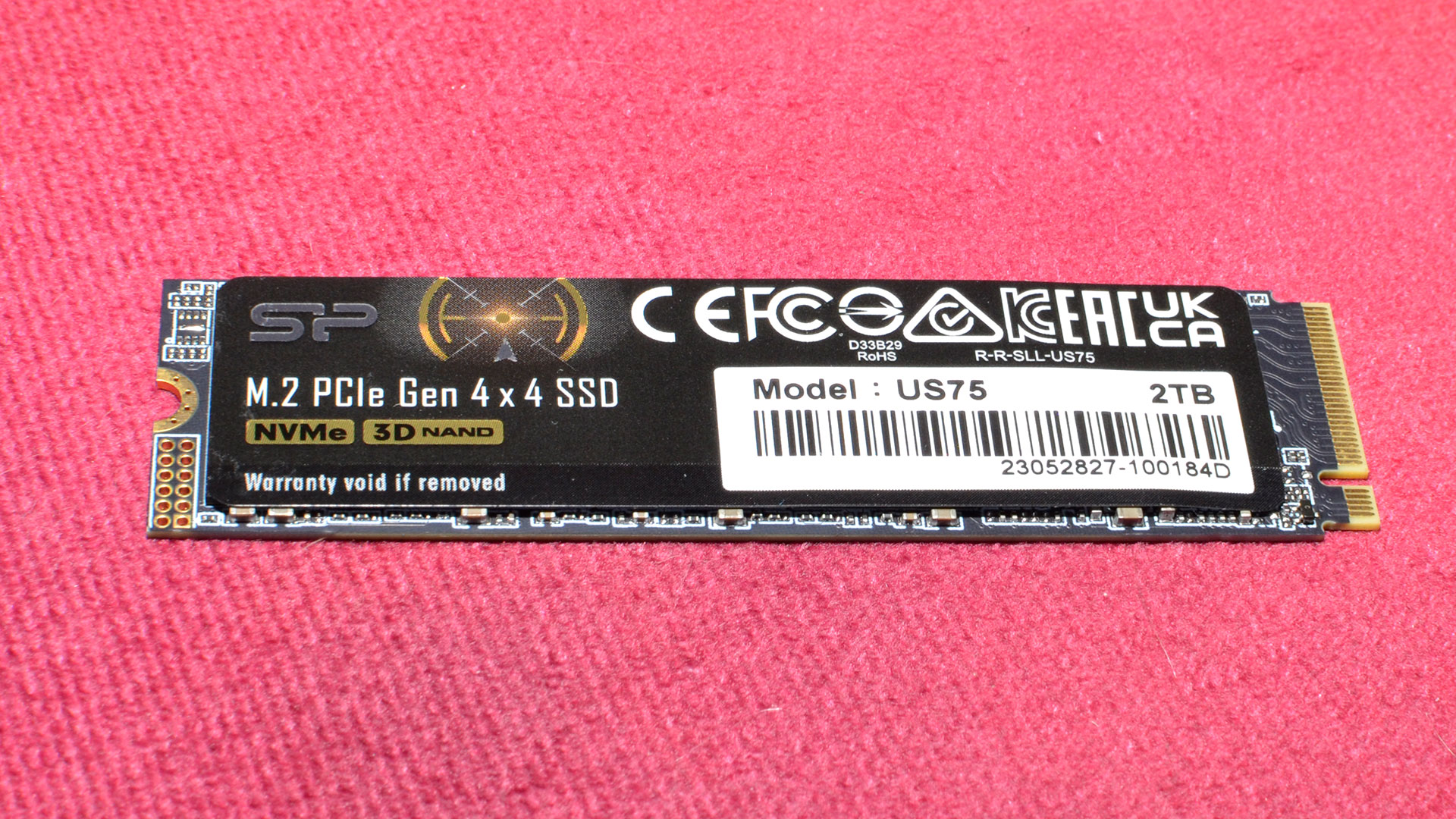Why you can trust Tom's Hardware
Comparison Products
The market has a lot of competition, and we want to see where the Silicon Power US75 falls. PCIe 5.0 is represented by the Crucial T700, one of the fastest SSDs we’ve so far tested, with perhaps the exception of the similar Teamgroup Cardea Z540. Other staple products from Crucial include the P5 Plus, which the T500 has replaced in many ways - the latter punches above its weight as a potential game-changer, directly challenging drives like the US75 and even higher-end models. There’s also the budget QLC-based Corsair MP600 Core XT, which is often a good choice at 4TB to shave a few bucks.
High-end PCIe 4.0 offerings are plentiful, with the Phison E18-based FireCuda 530, the InnoGrit IG5236-based Acer Predator GM7000, and the SMI SM2264-based Adata Legend 960 Max. Faster in-house designs include the Solidigm P44 Pro and Samsung 990 Pro, the latter of which we recently reviewed again with the launch of the 4TB variant. The US75 also has a direct rival in the recently-reviewed Teamgroup MP44.
Trace Testing - 3DMark Storage Benchmark
Built for gamers, 3DMark’s Storage Benchmark focuses on real-world gaming performance. Each round in this benchmark stresses storage based on gaming activities including loading games, saving progress, installing game files, and recording gameplay video streams.
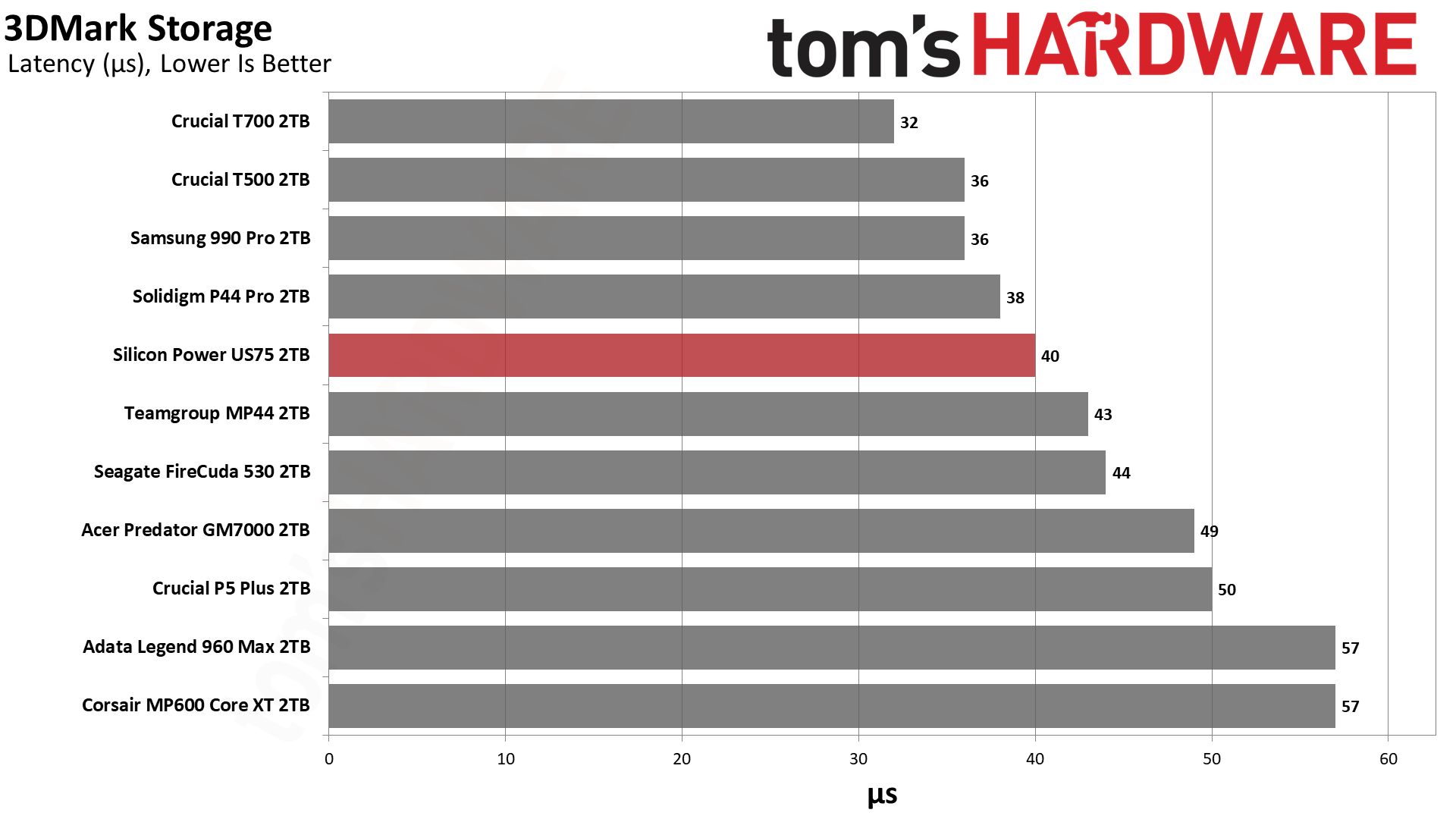
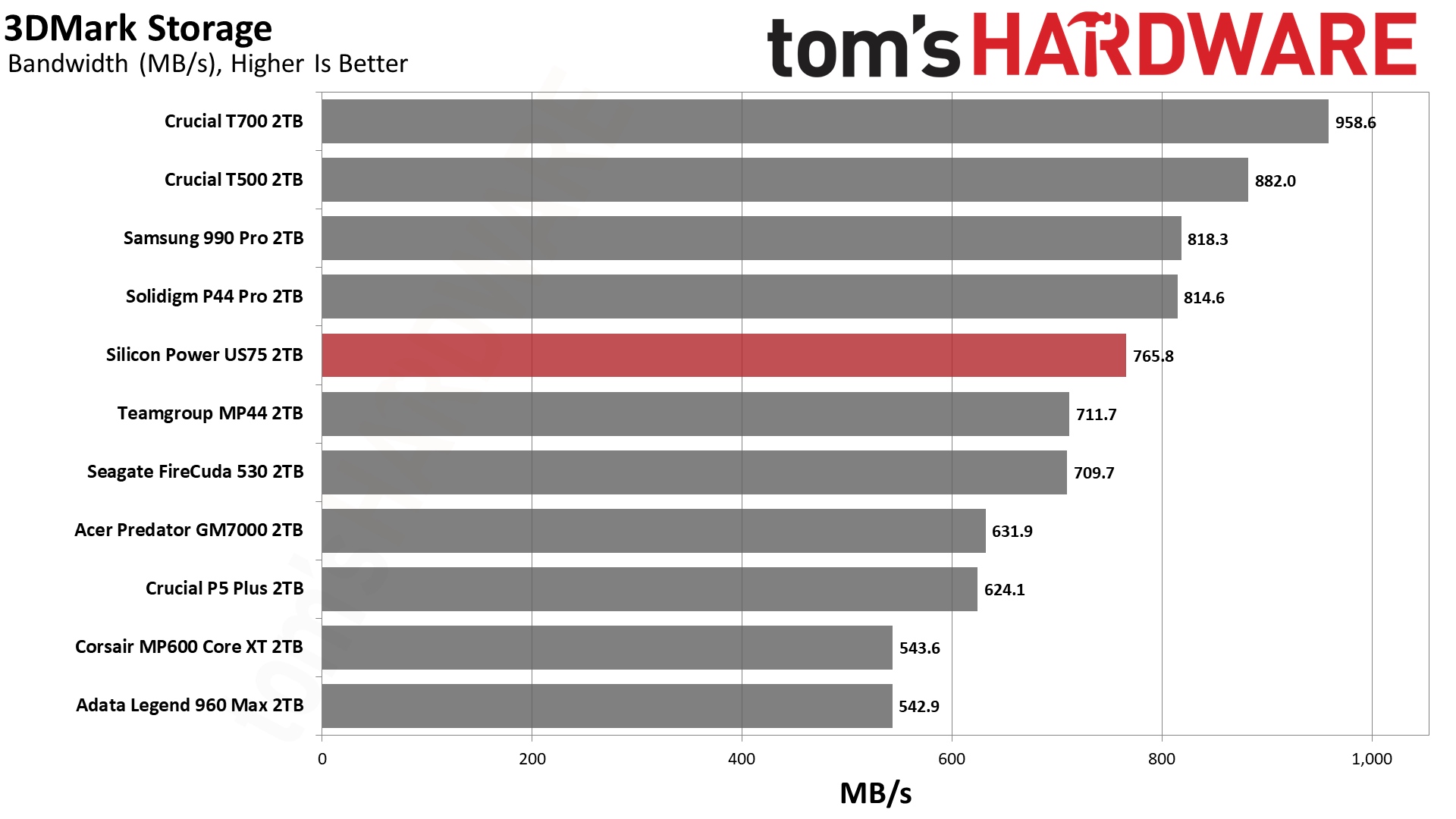
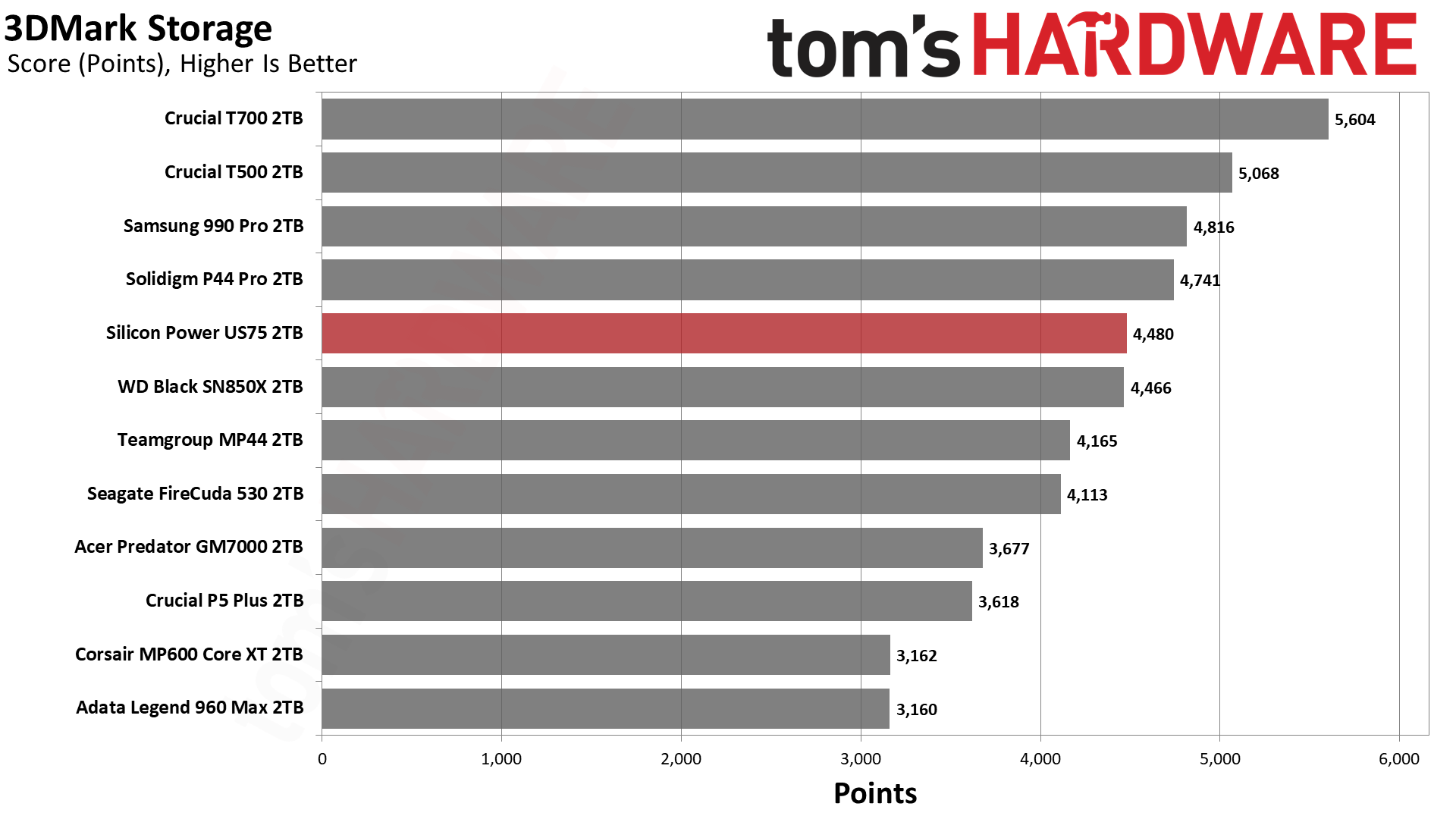
The US75 is average to above average in 3DMark, falling one place behind the P44 Pro in every test. This is not unimpressive, but it does demonstrate that the US75 cannot fully replace the fastest PCIe 4.0 drives on the market.
In the future, DirectStorage performance may become more important. However, the new T500 does have Phison’s DirectStorage-optimized firmware and competes in the same space as the US75, so that helps differentiate the SSDs in this lineup. The T500 is clearly faster in 3DMark, too.
Trace Testing – PCMark 10 Storage Benchmark
PCMark 10 is a trace-based benchmark that uses a wide-ranging set of real-world traces from popular applications and everyday tasks to measure the performance of storage devices.
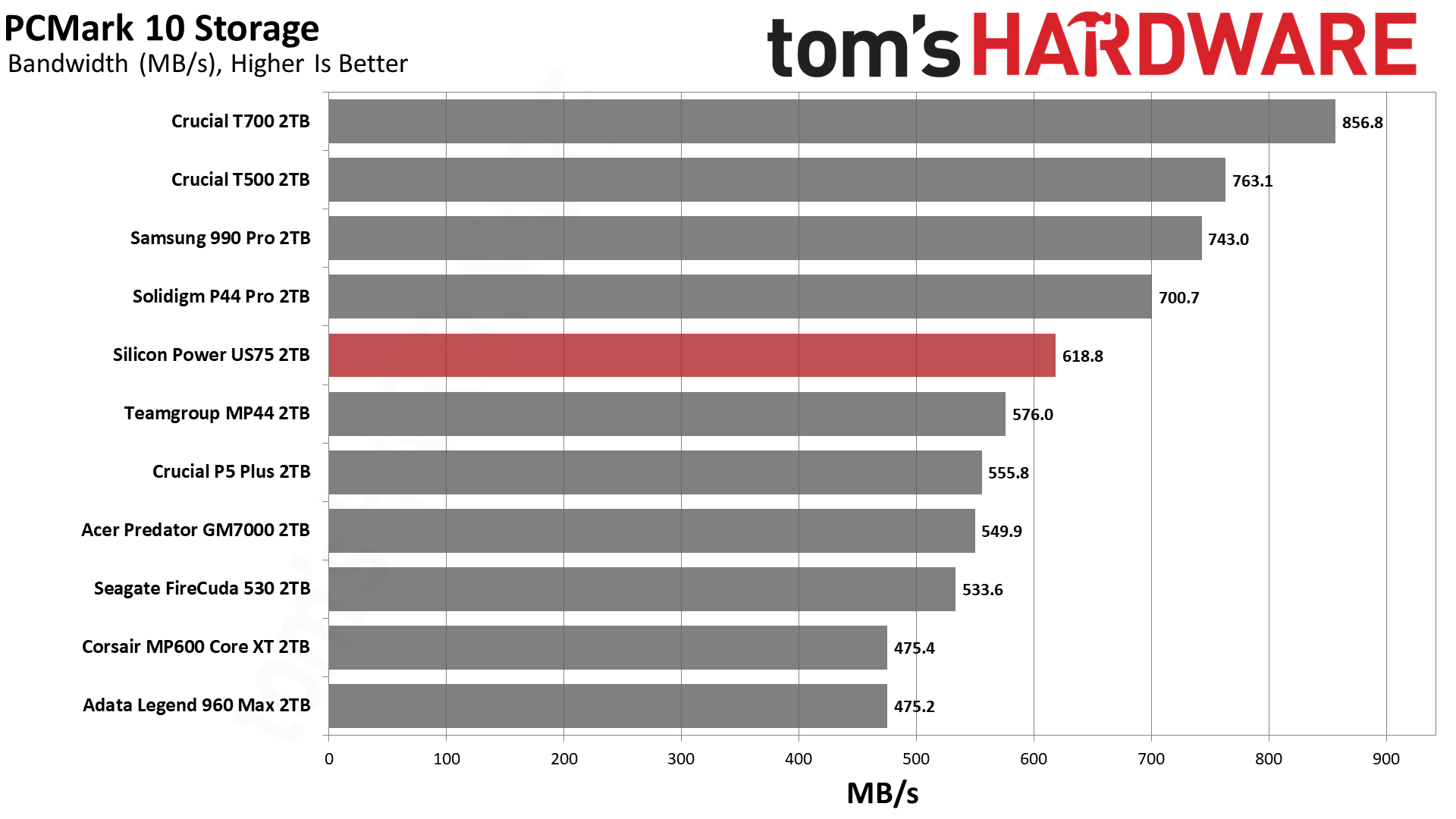
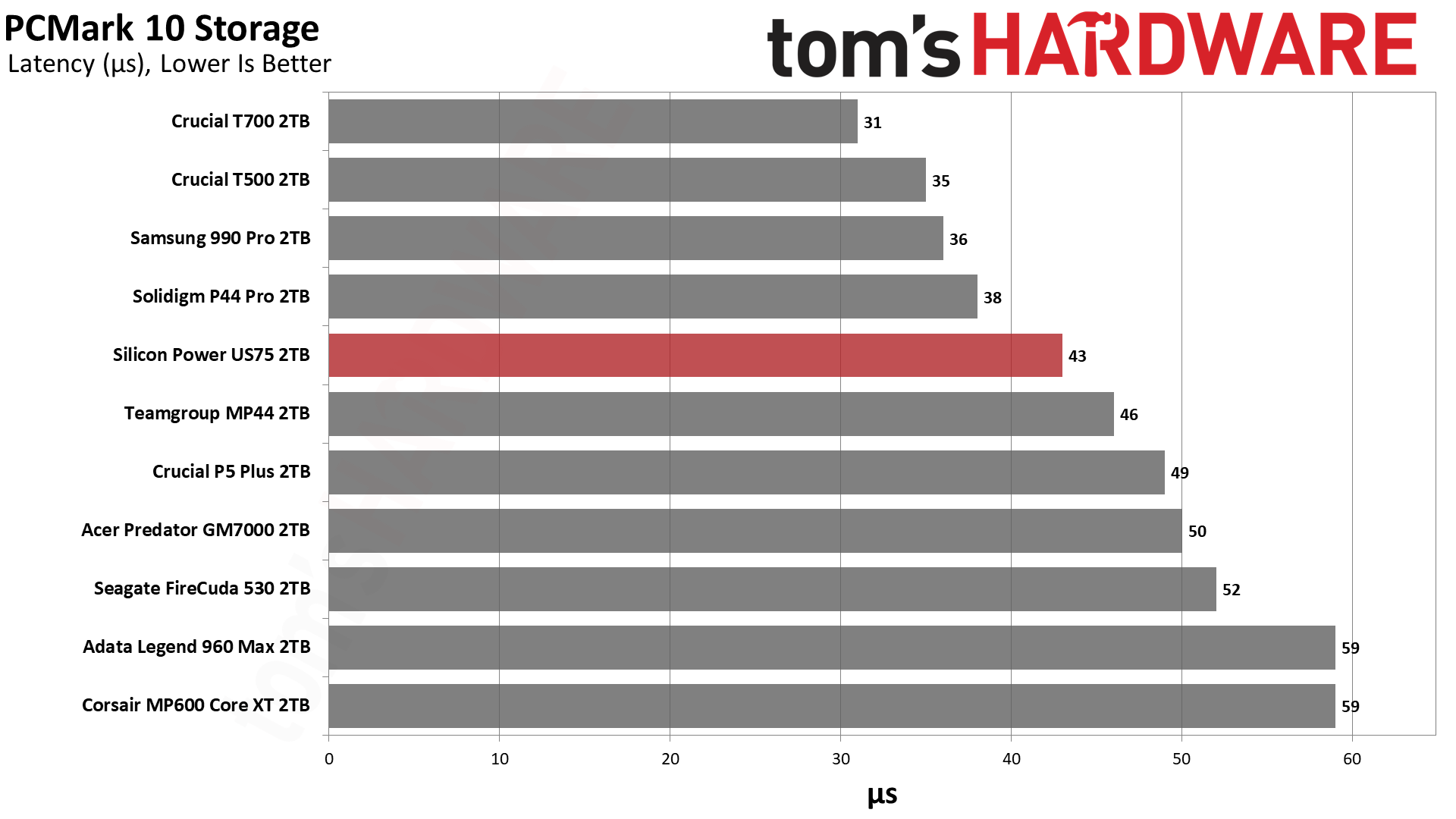
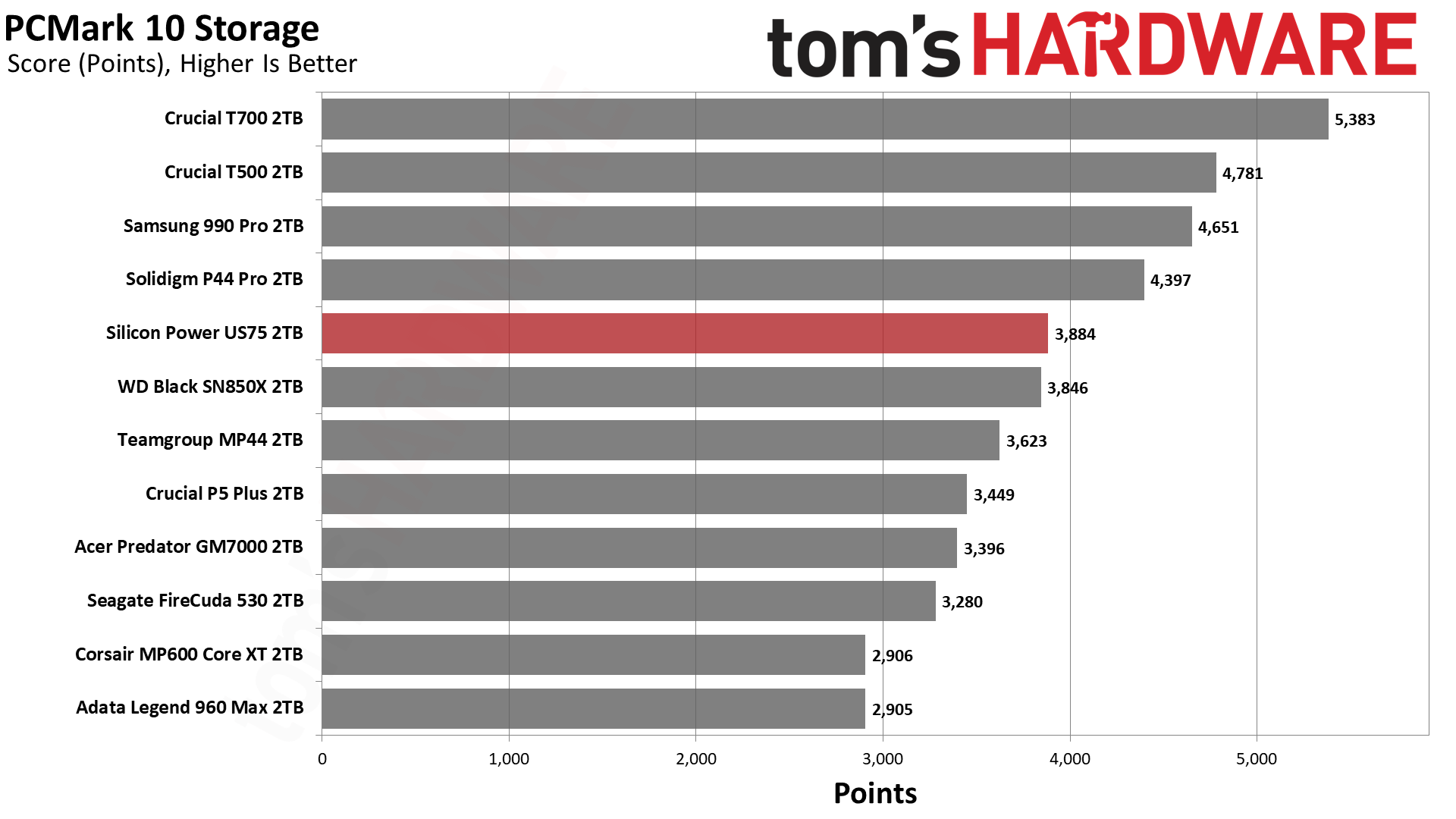
The US75 falls into the same spot with PCMark 10, again trailing the P44 Pro by one place in each result. The T500 continues to throw its weight around. That’s not to say the US75 does poorly, as its performance here shows that it would be perfectly suitable for use as your primary drive. It just means that it has to undercut the T500 on price.
Get Tom's Hardware's best news and in-depth reviews, straight to your inbox.
Console Testing: PlayStation 5 Transfers
The PlayStation 5 is capable of taking one additional PCIe 4.0 or faster SSD for extra game storage, with some requirements. Launch models could not take 8TB drives but this limit has since been removed. While any 4.0 drive will work, Sony specifies drives that can deliver at least 5,500 MB/s of sequential read bandwidth are optimal. The PS5 does not support the host memory buffer (HMB) feature but DRAM-less drives will still work. In our testing, PCIe 5.0 SSDs performed irregularly and should not be used in the PS5, especially as they may require additional cooling. Please see our Best PS5 SSDs article for more information.
Our testing utilizes the PS5’s internal storage test and manual read/write tests with over 192GB of data both from and to the internal storage. Throttling is prevented where possible.
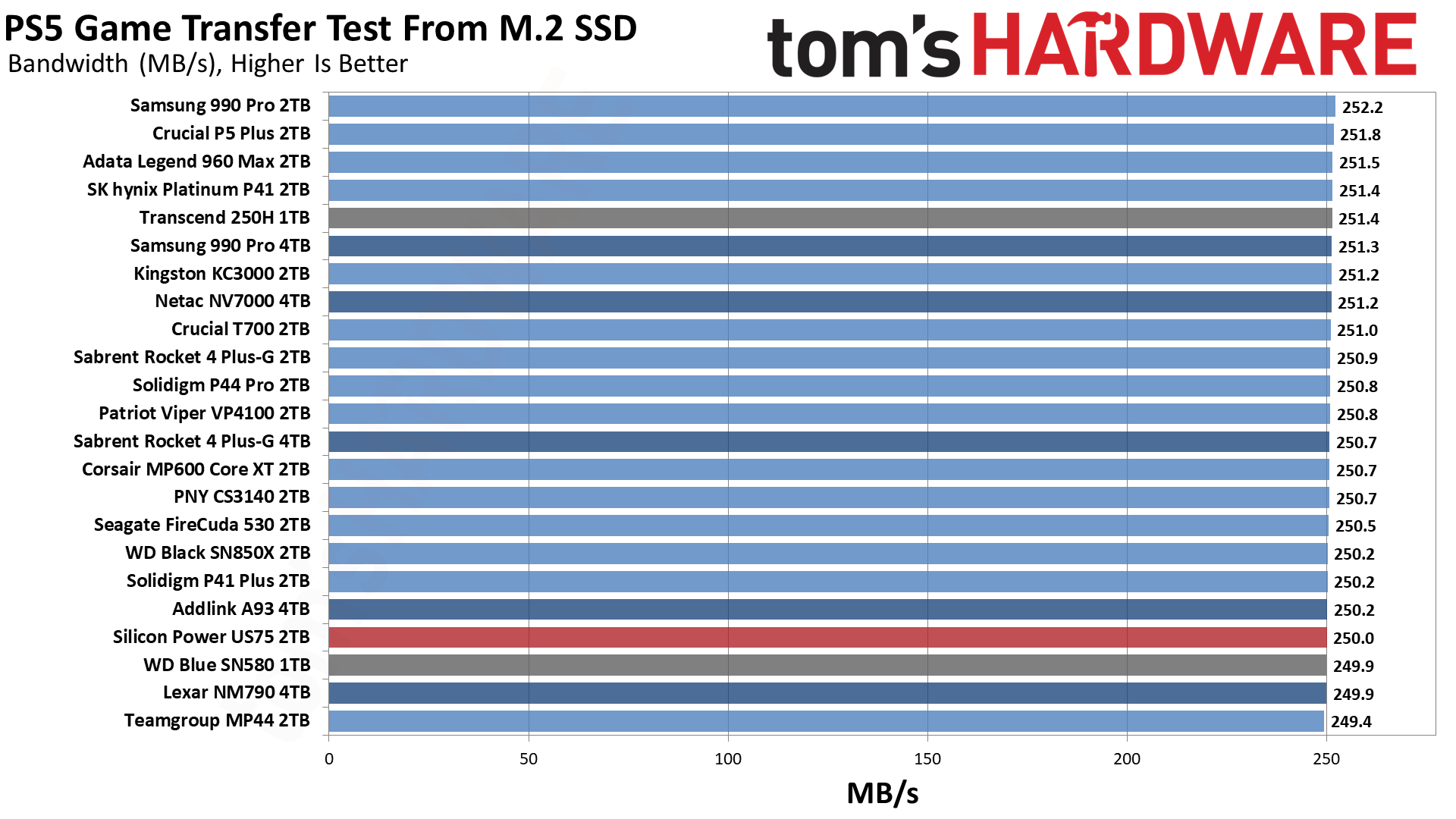
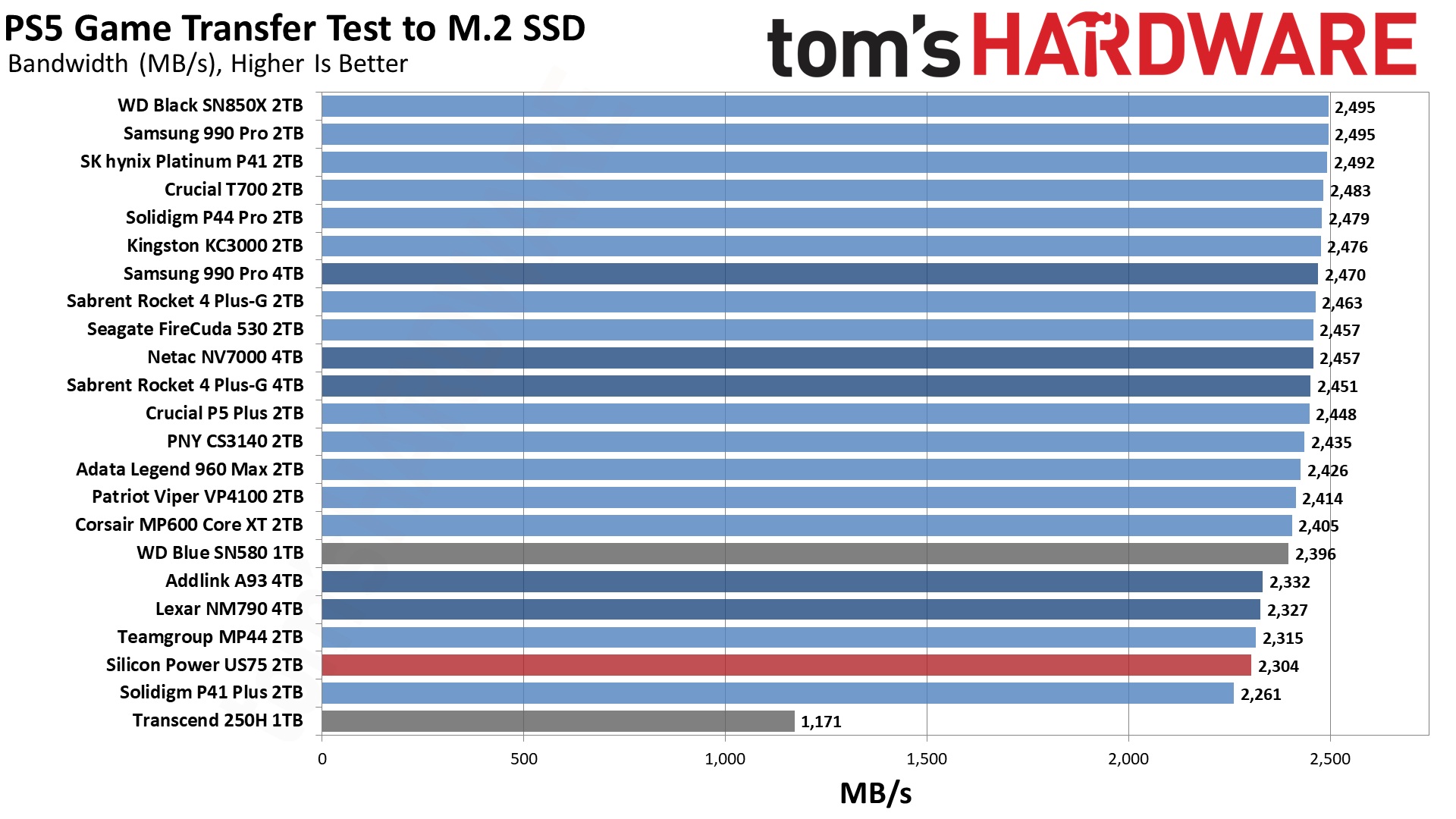
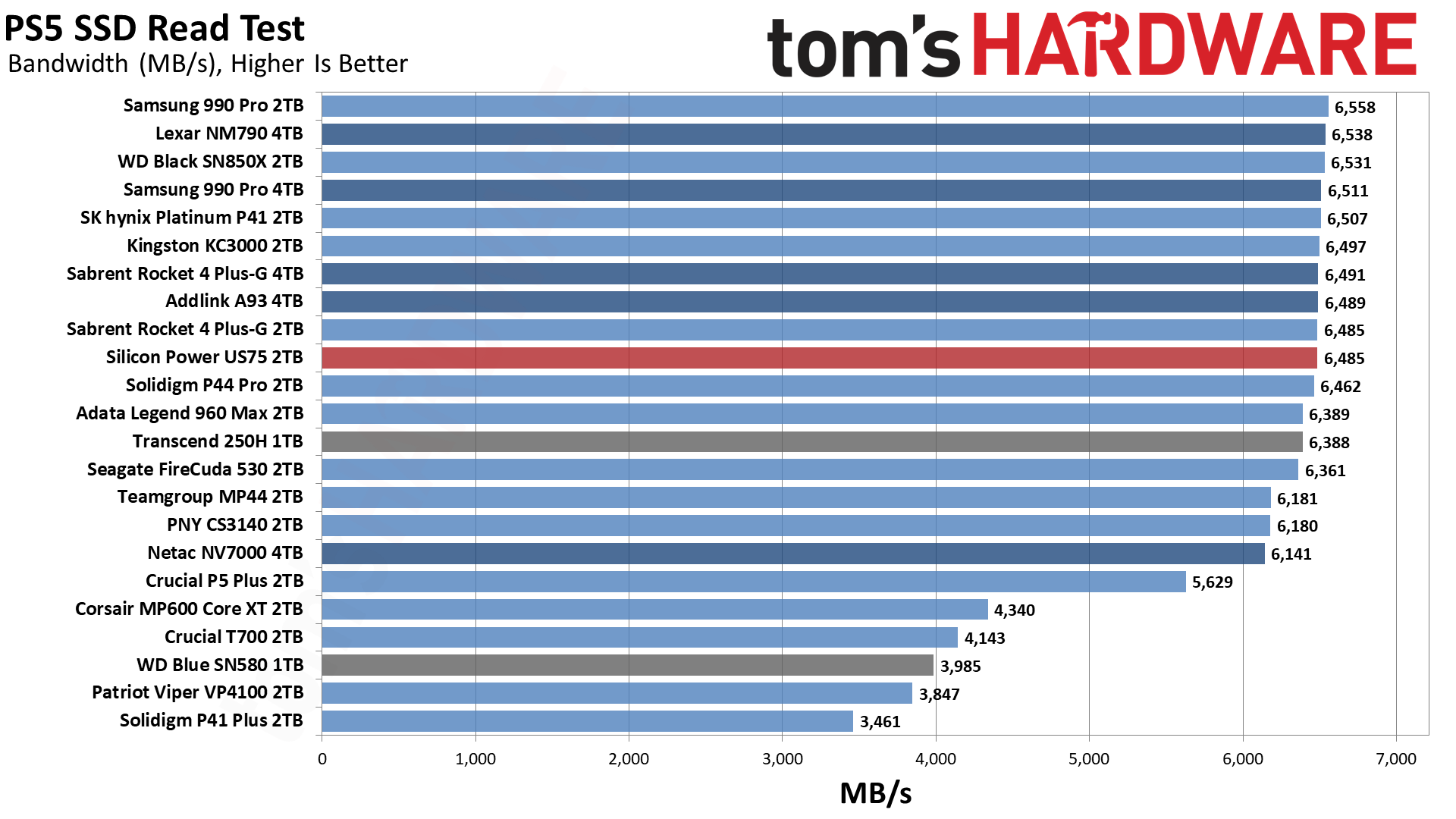
The US75 performs perfectly well for the PS5. In fact, we think this and similar drives - like the Lexar NM790 - are the perfect choice for the console. The prices are best with capacity, especially at 4TB, which is really all you need.
A heatsink would be a nice bonus, which is probably why Lexar now has a separate SKU for the NM790 that comes with a heatsink, competing with the Addlink A93. A heatsink is not strictly necessary, but it’s a consideration if you’re looking at the US75 for your console. It does need to be priced under the heatsink-equipped competitors to be the best value.
Transfer Rates – DiskBench
We use the DiskBench storage benchmarking tool to test file transfer performance with a custom, 50GB dataset. We copy 31,227 files of various types, such as pictures, PDFs, and videos to a new folder and then follow-up with a reading test of a newly-written 6.5GB zip file.
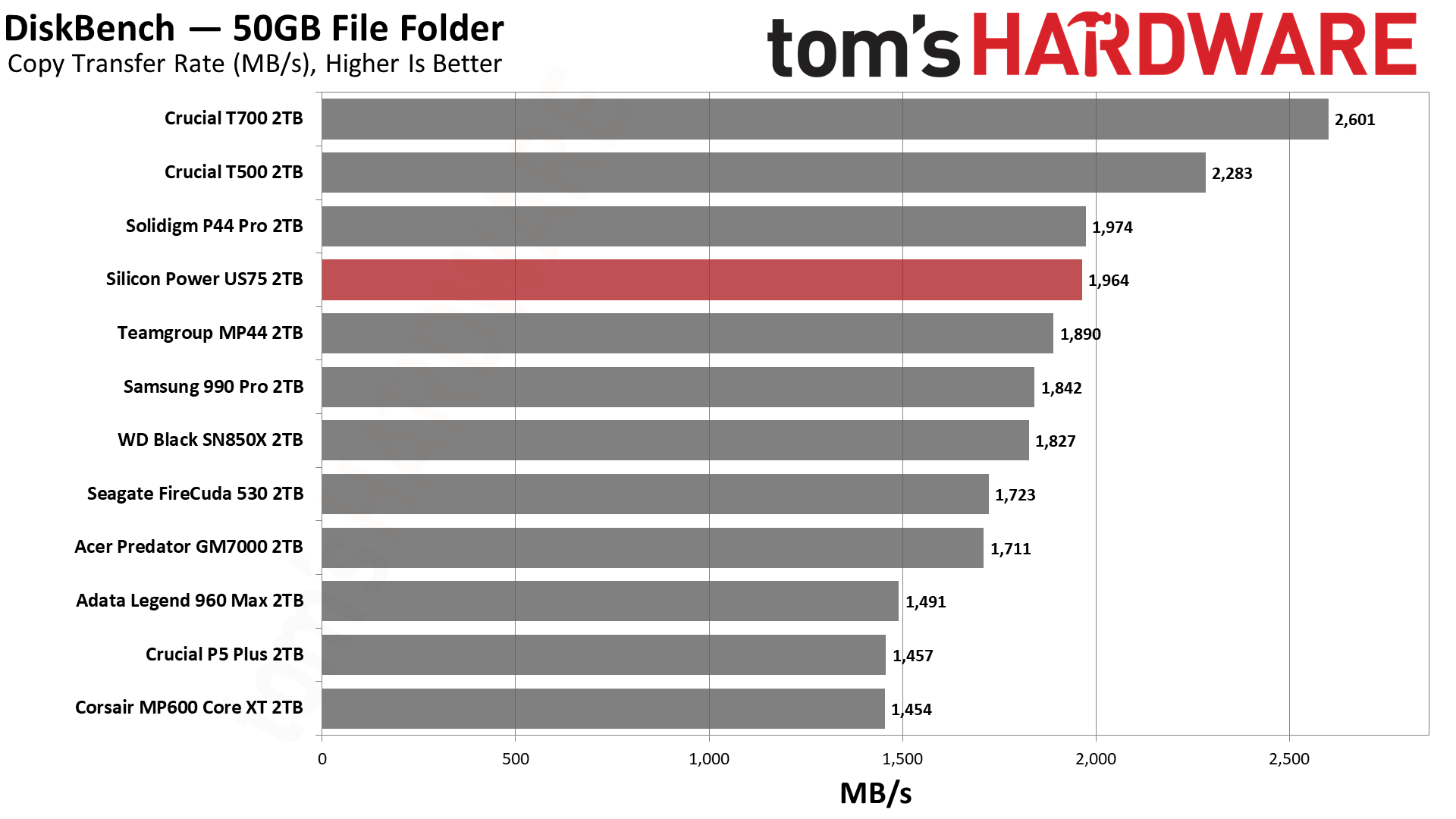
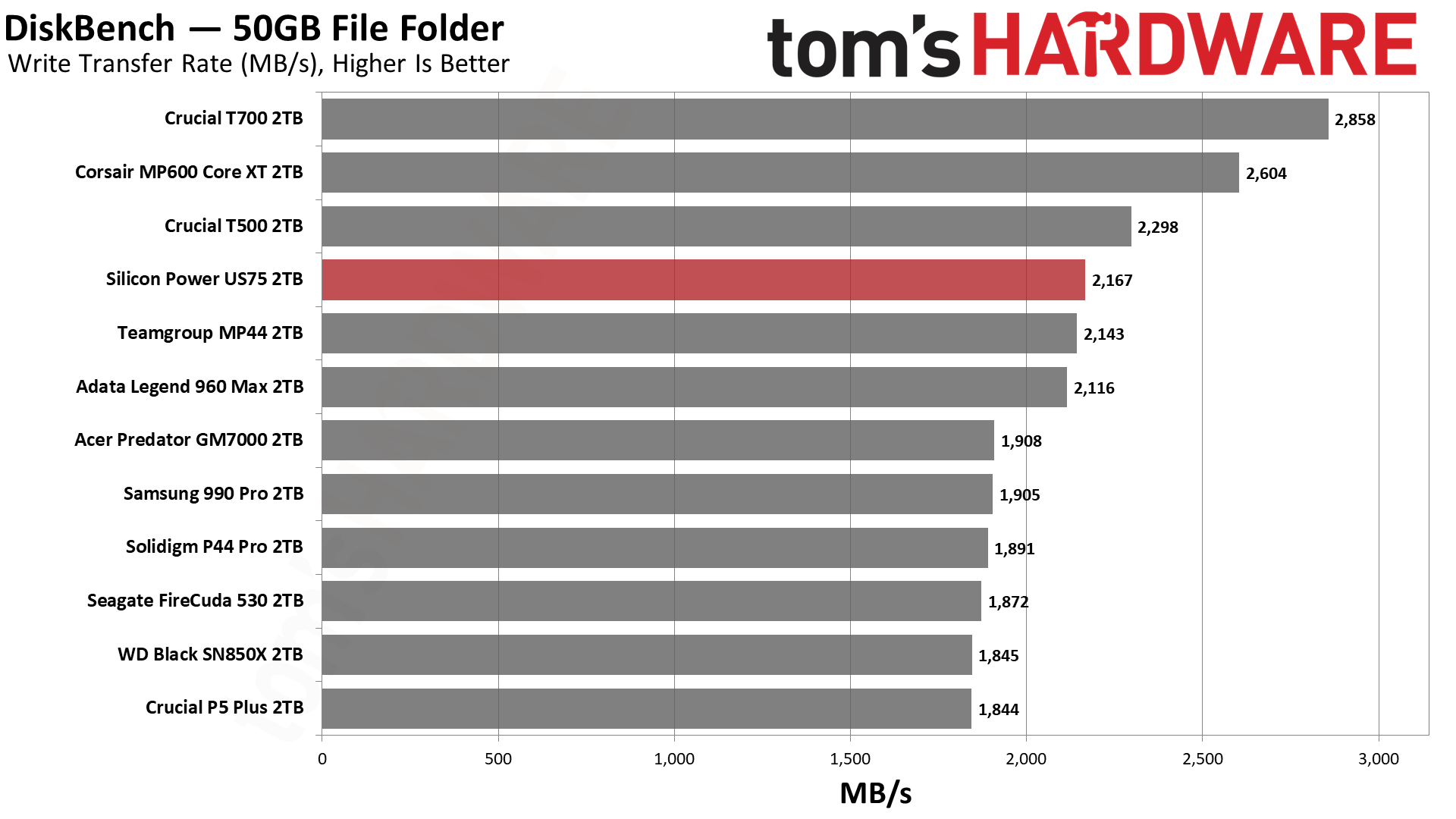
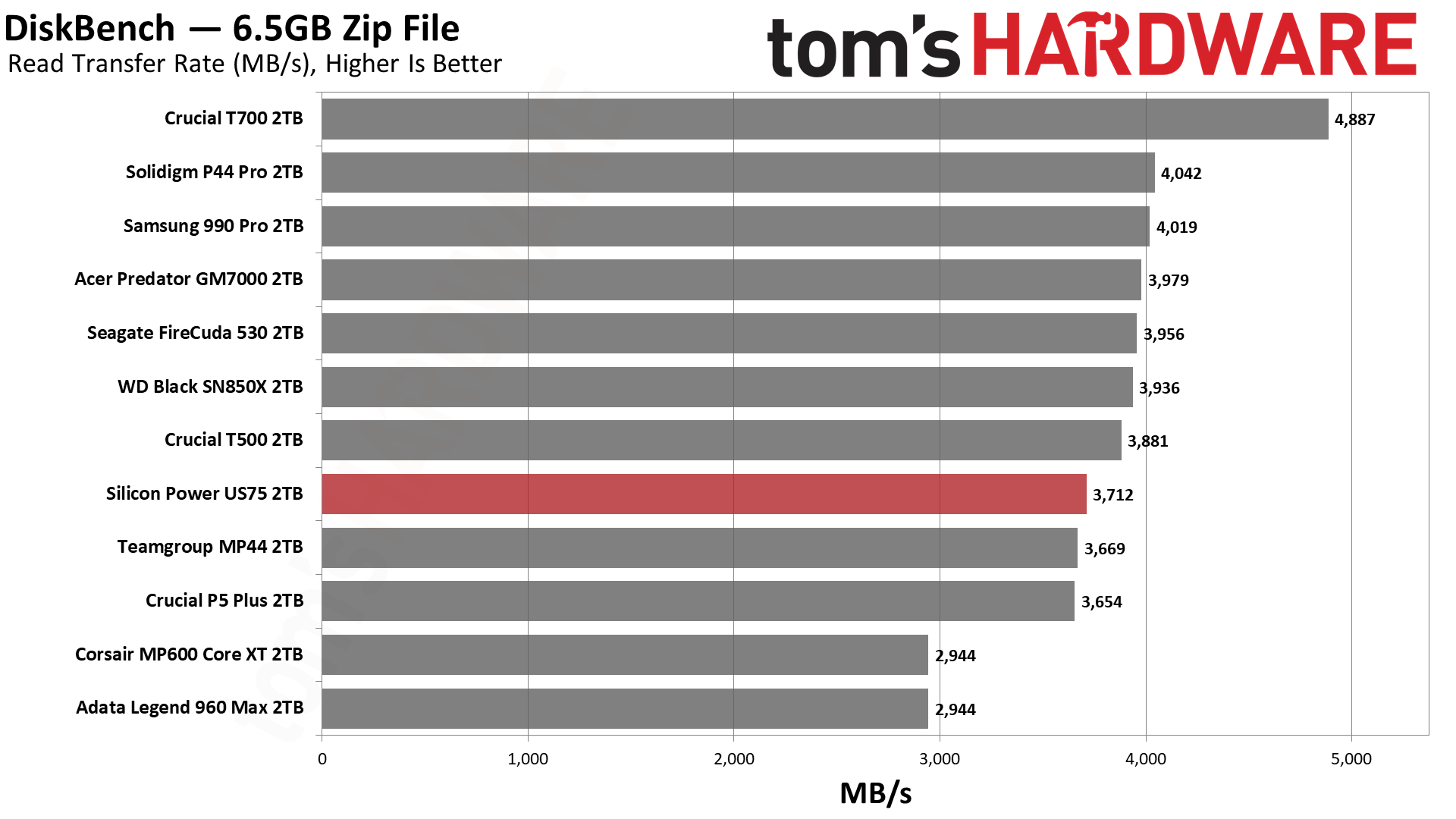
It’s easy to think any SSD is overkill for everyday use, but then you find yourself transferring or copying a bunch of files, and that timer awakens the power user inside. HDDs are fine for long-term storage but it’s nice to have some pickup-and-go on your faster drives. The US75 feels surprisingly spry for a budget drive, matching even the P44 Pro in copy speed. It’s no match for a PCIe 5.0 drive, but it’ll get the job done for PCIe 4.0 slots.
Synthetic Testing - ATTO / CrystalDiskMark
ATTO and CrystalDiskMark (CDM) are free and easy-to-use storage benchmarking tools that SSD vendors commonly use to assign performance specifications to their products. Both of these tools give us insight into how each device handles different file sizes.
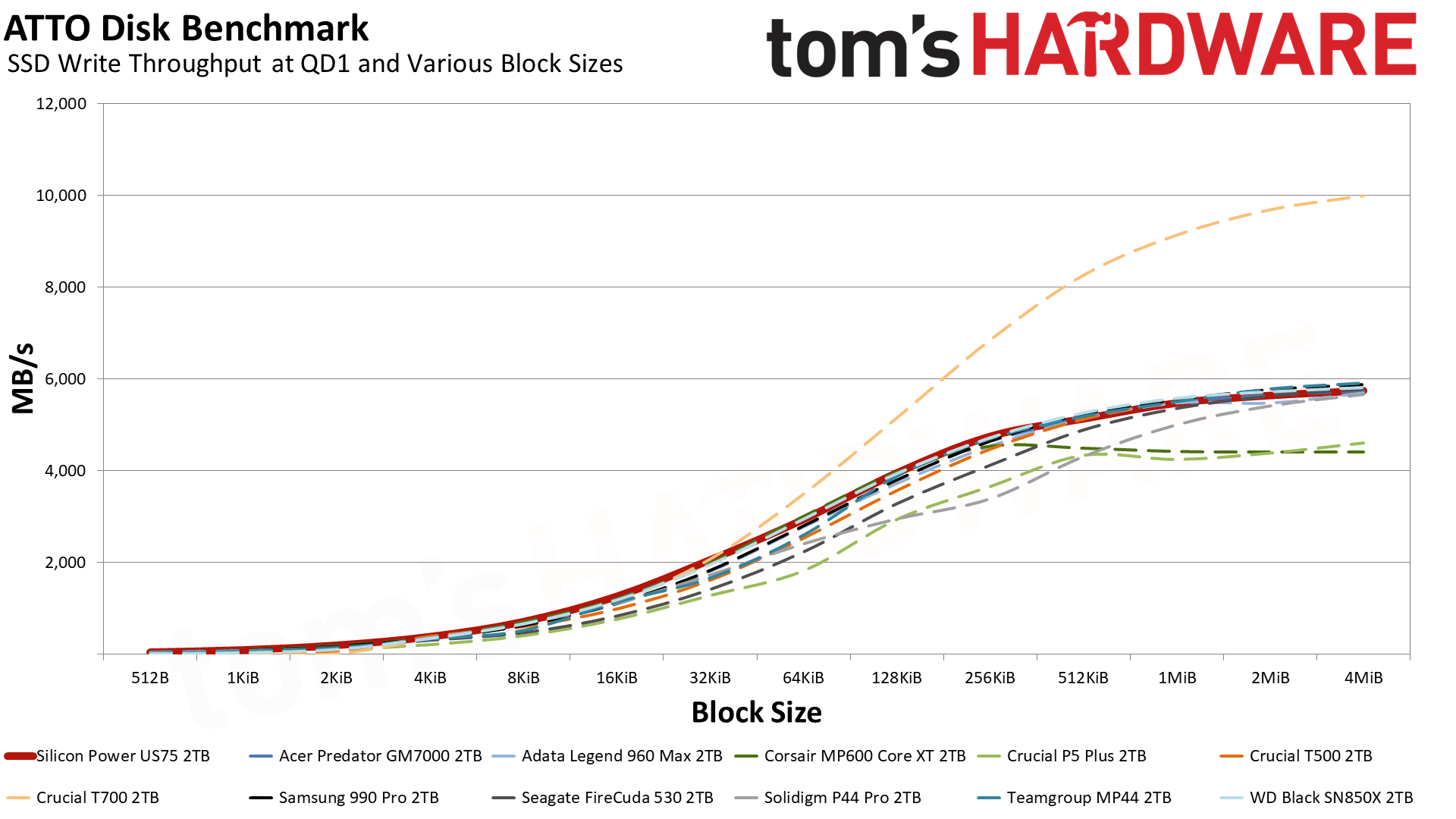
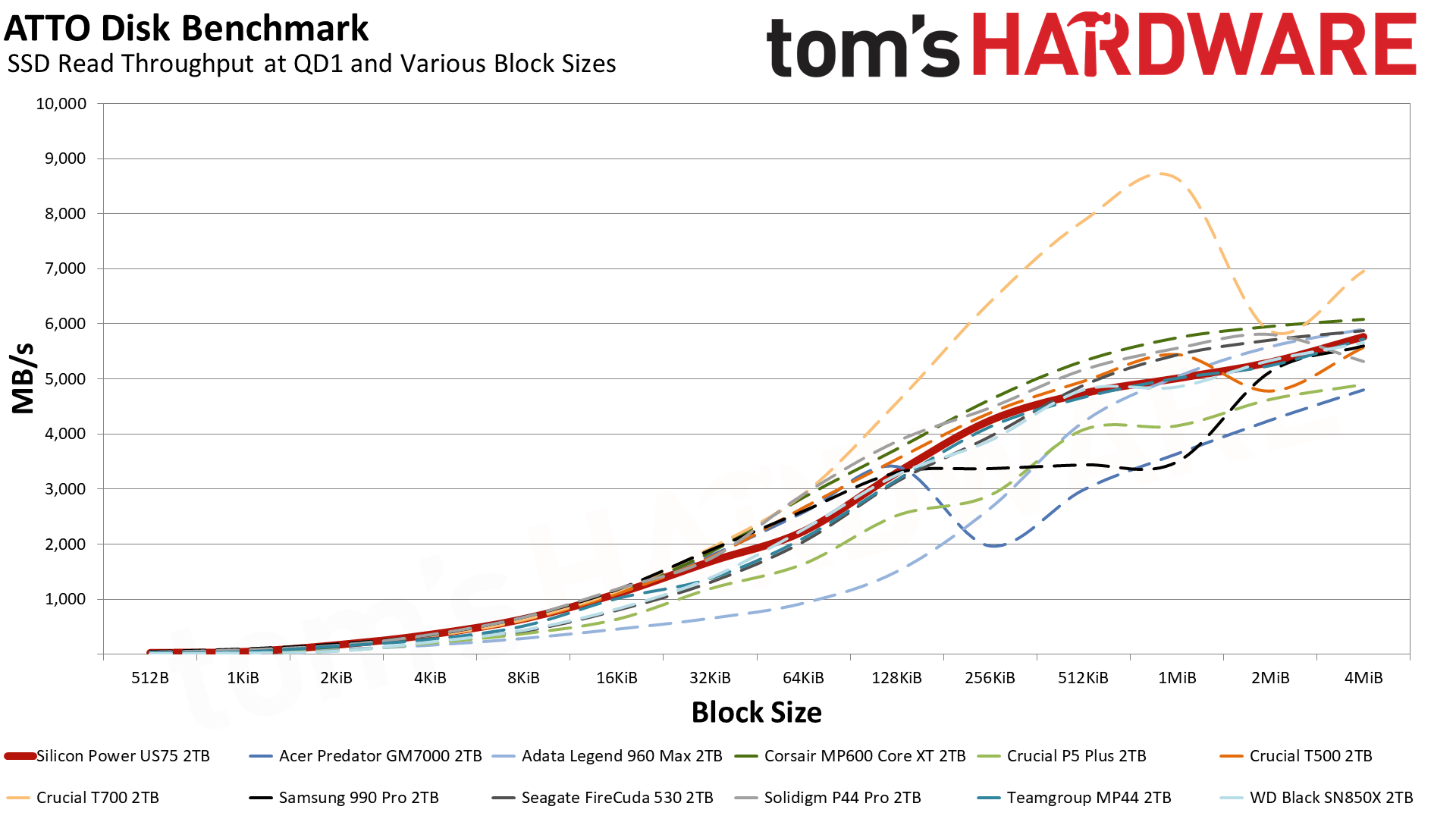
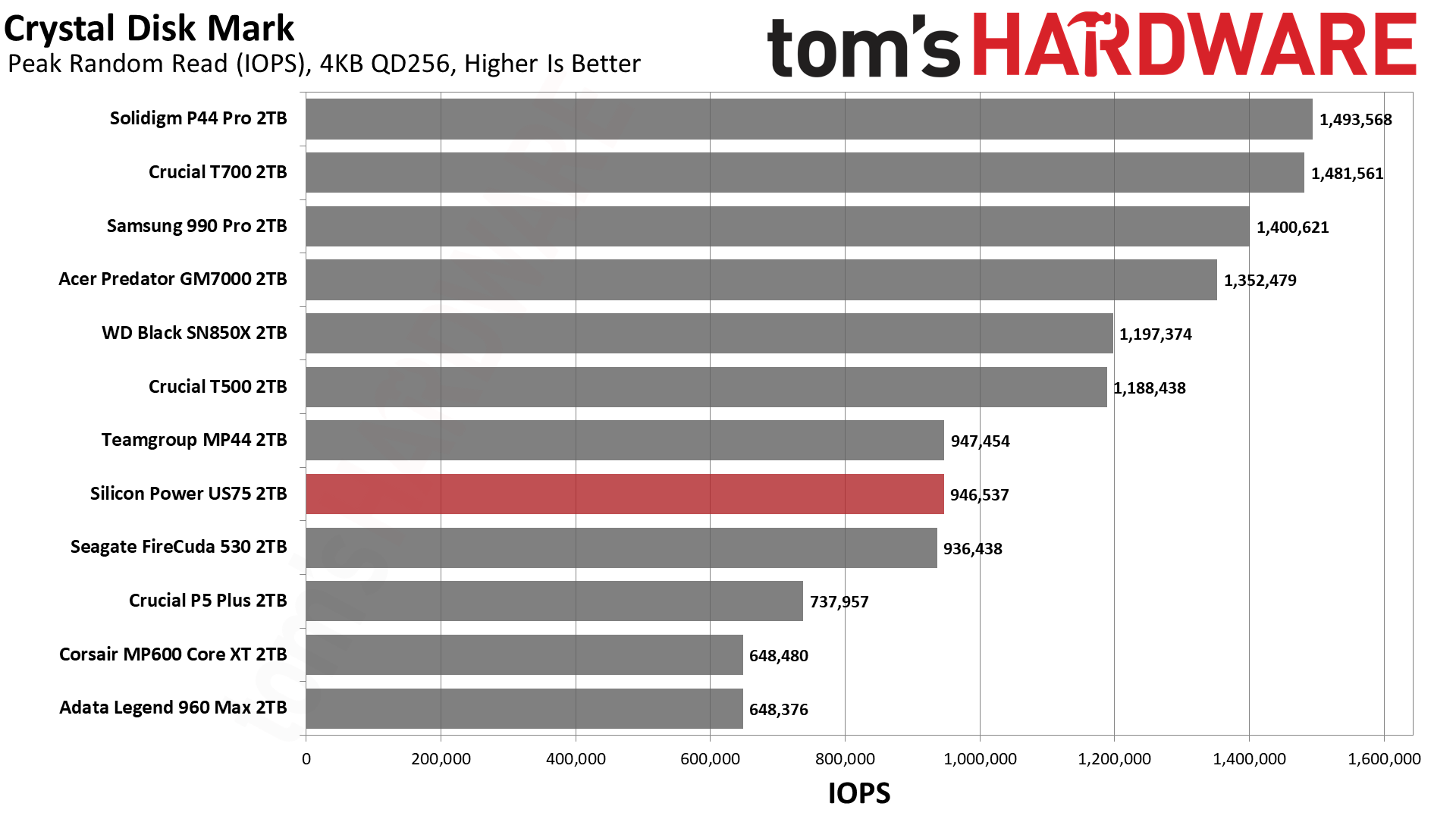
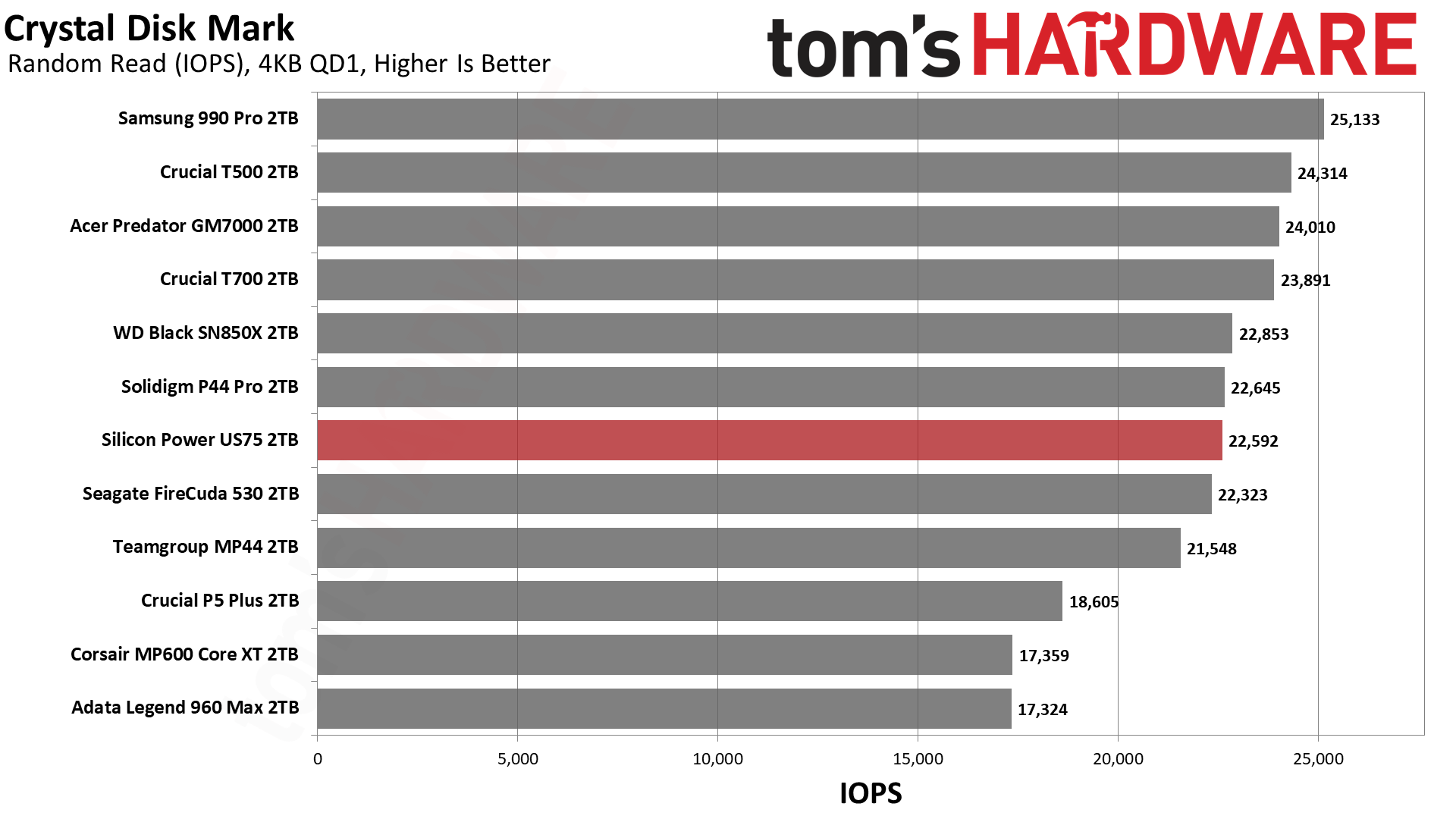
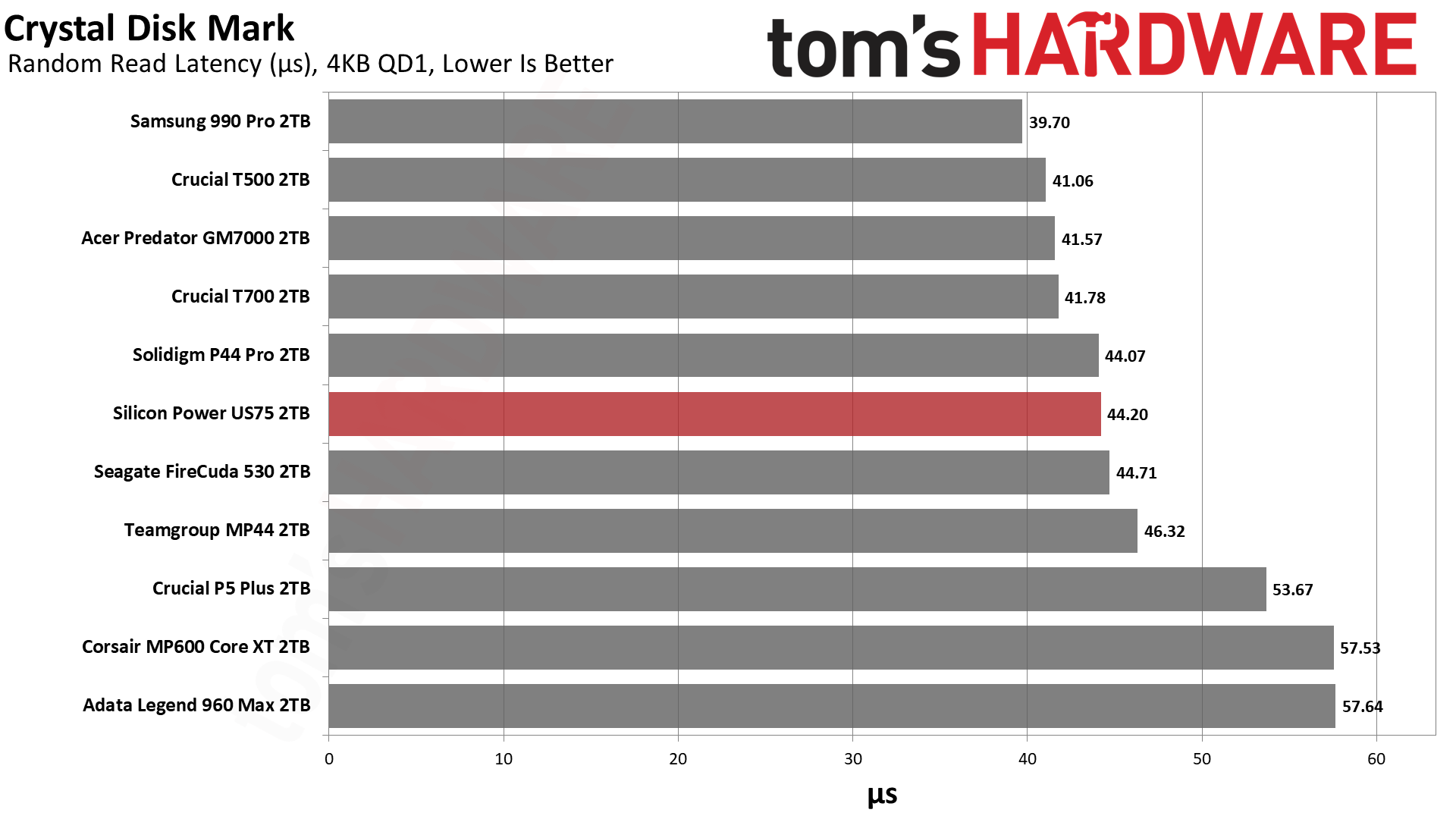
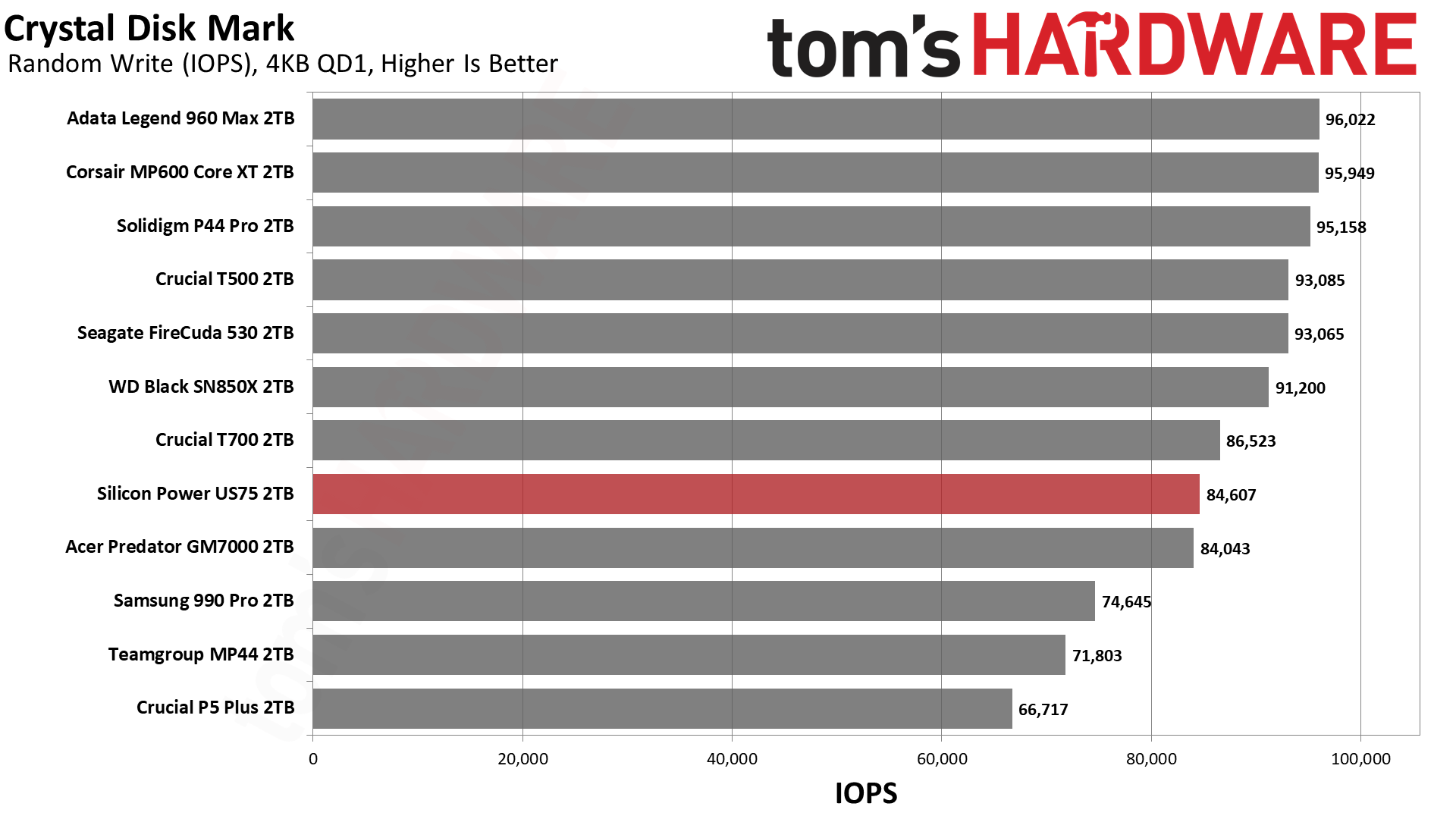
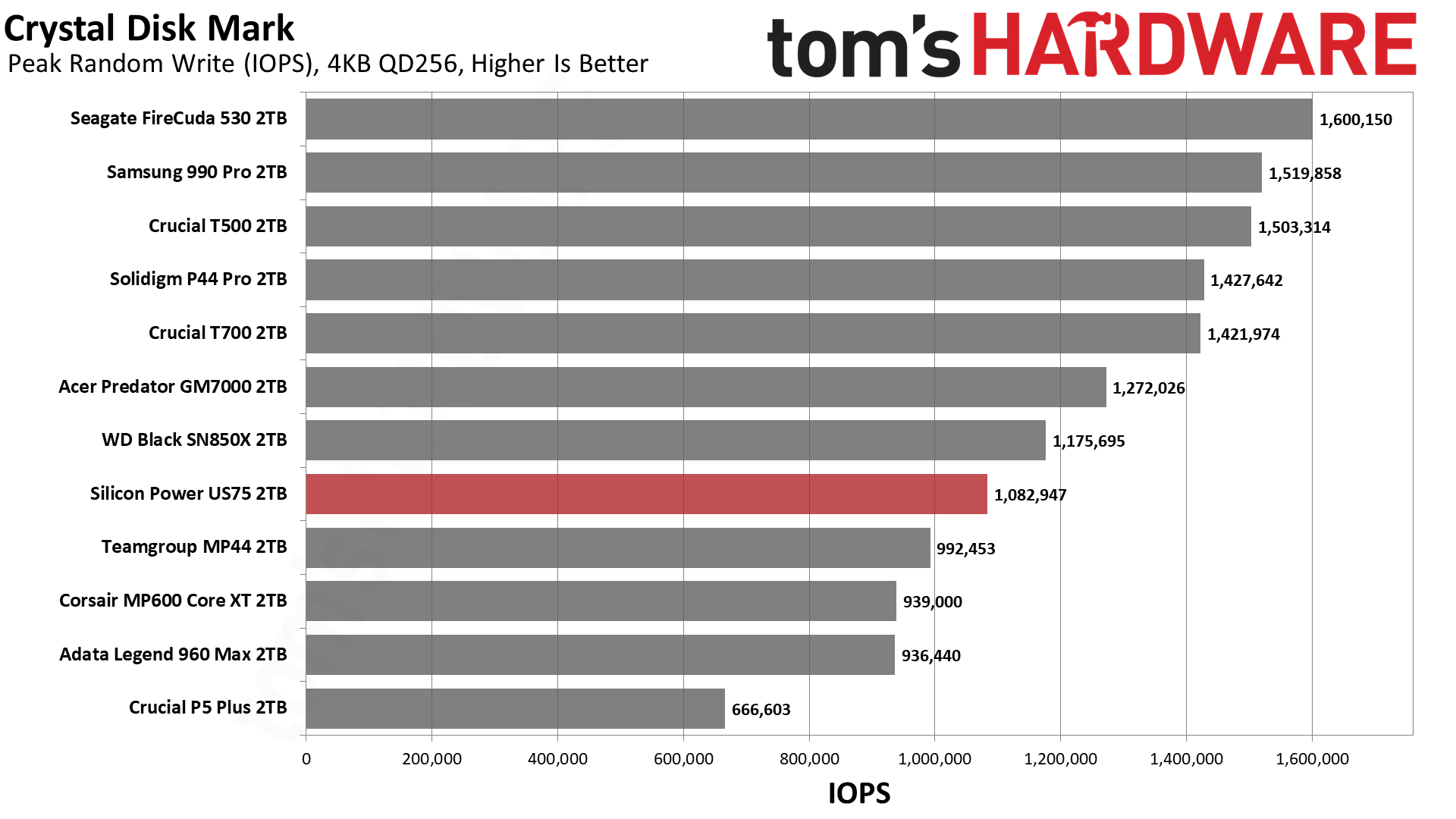
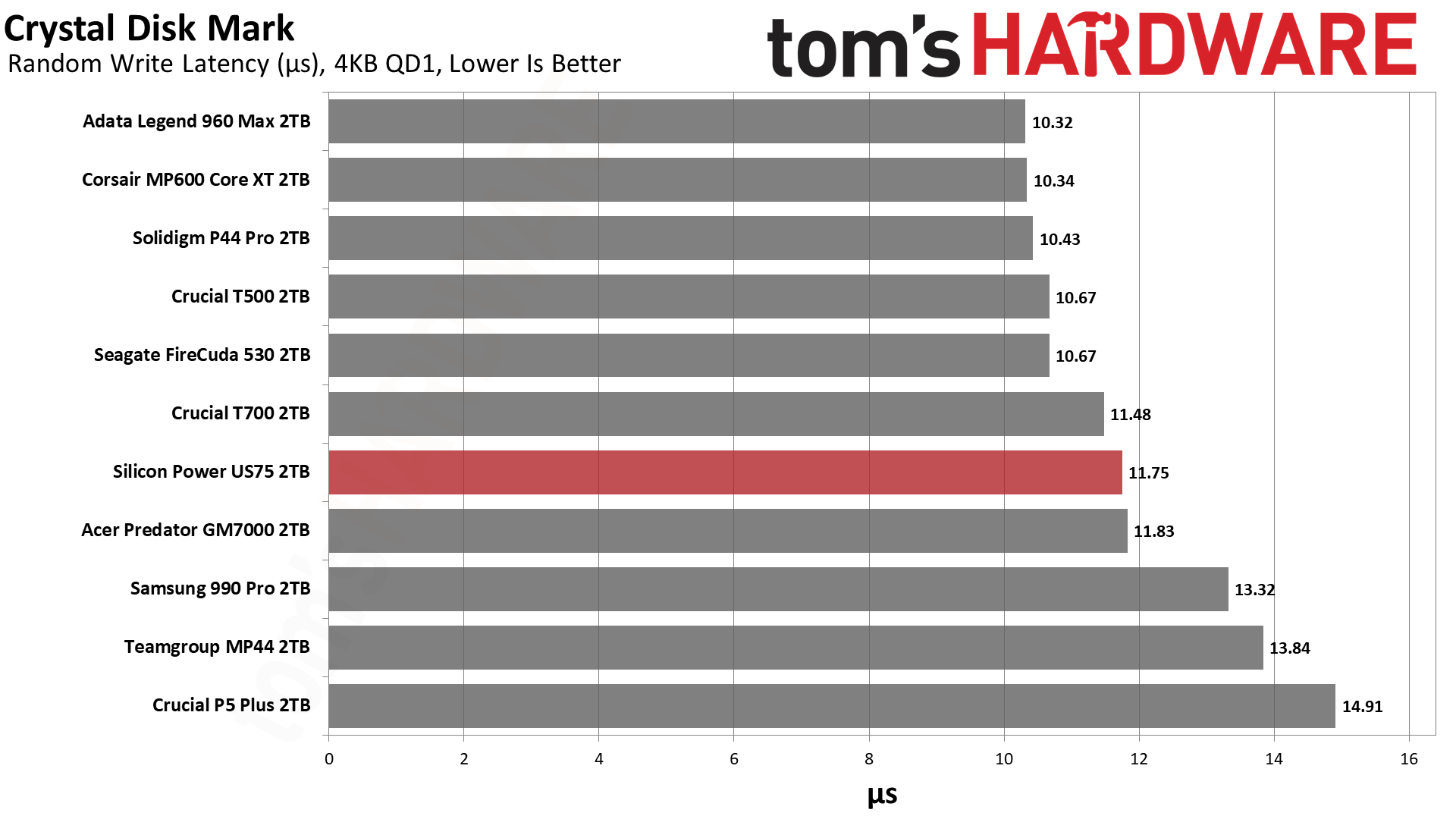
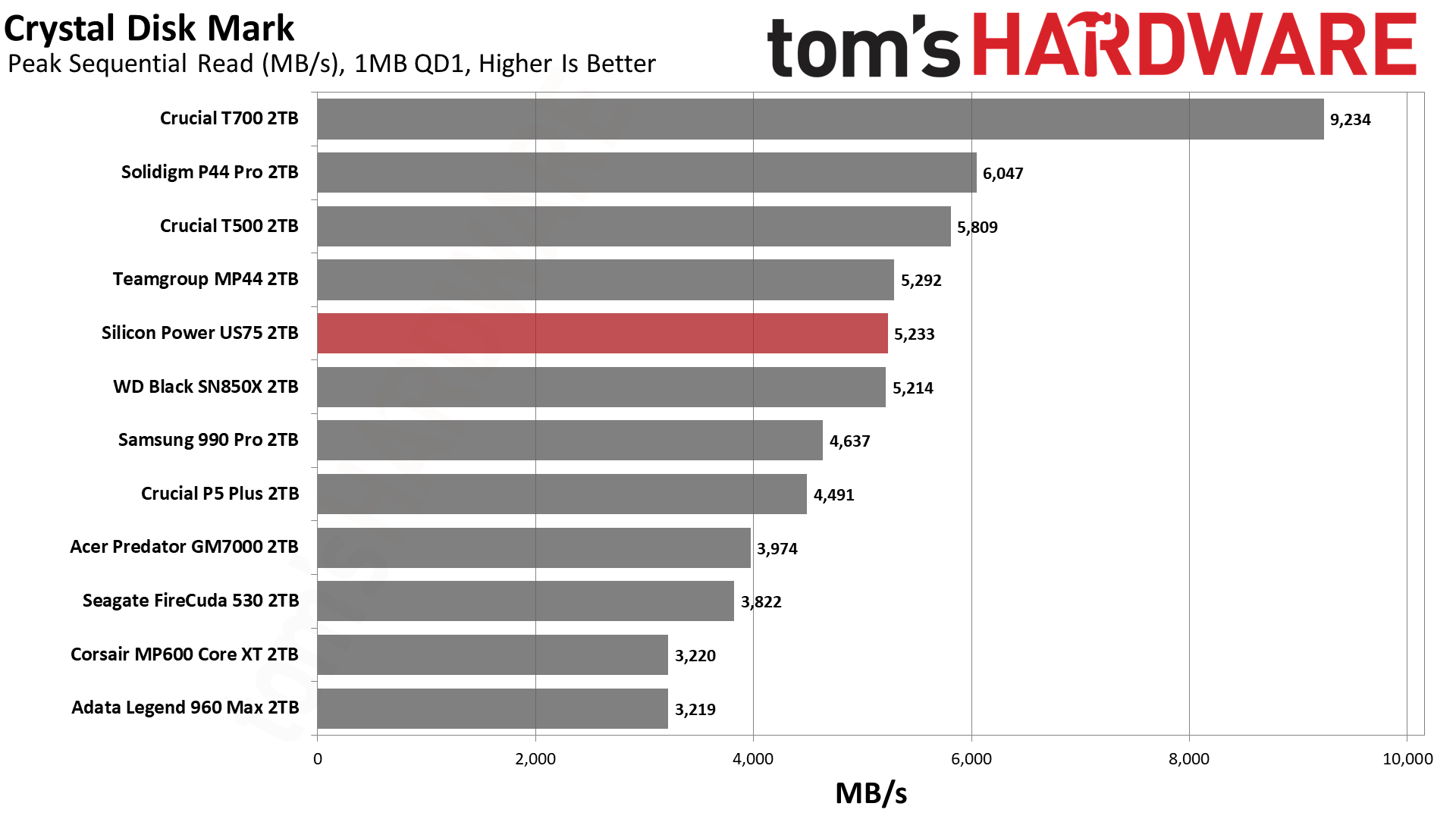
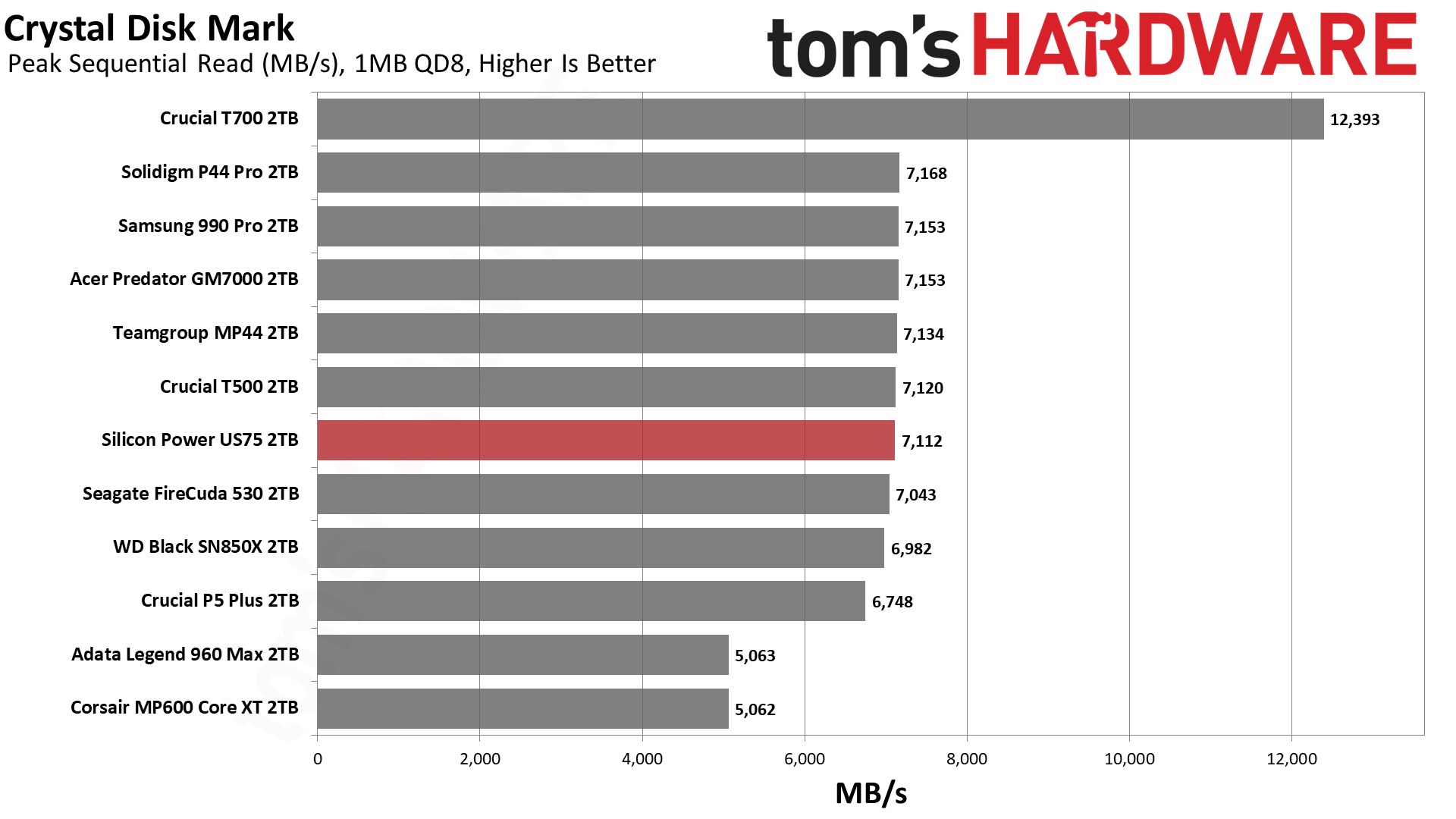


Performance in the ATTO write workload is nice and even, but the reads are a little bumpy. This should not be a factor in daily use, but we do see more consistent results from some other drives, like the T500. Sequential performance is what’s on the box but can be misleading, especially as it’s usually given for QD32. Your most typical operations will only be at QD1, and here, the US75 is plenty fast for both reads and writes, according to CDM. The T500 continues to impress, and the PCIe 5.0 T700 leaves the other drives in the dust.
Low queue depth random performance, on the other hand, tends to reflect the real-world experience more accurately. The US75 is fast enough in this regard but trails the 990 Pro and T500. When the QD is pumped up, the US75 falls even more behind. This is where the T500’s raw power shines through and helps separate it from less expensive drives. This may also be a reason to go with the P44 Pro over the US75 at 2TB and below if you’re focused on heavier workloads when considering that the T500 falters with sustained writes.
Sustained Write Performance and Cache Recovery
Official write specifications are only part of the performance picture. Most SSDs implement a write cache, which is a fast area of (usually) pseudo-SLC programmed flash that absorbs incoming data. Sustained write speeds can suffer tremendously once the workload spills outside of the cache and into the "native" TLC or QLC flash.
We use Iometer to hammer the SSD with sequential writes for 15 minutes to measure both the size of the write cache and performance after the cache is saturated. We also monitor cache recovery via multiple idle rounds.
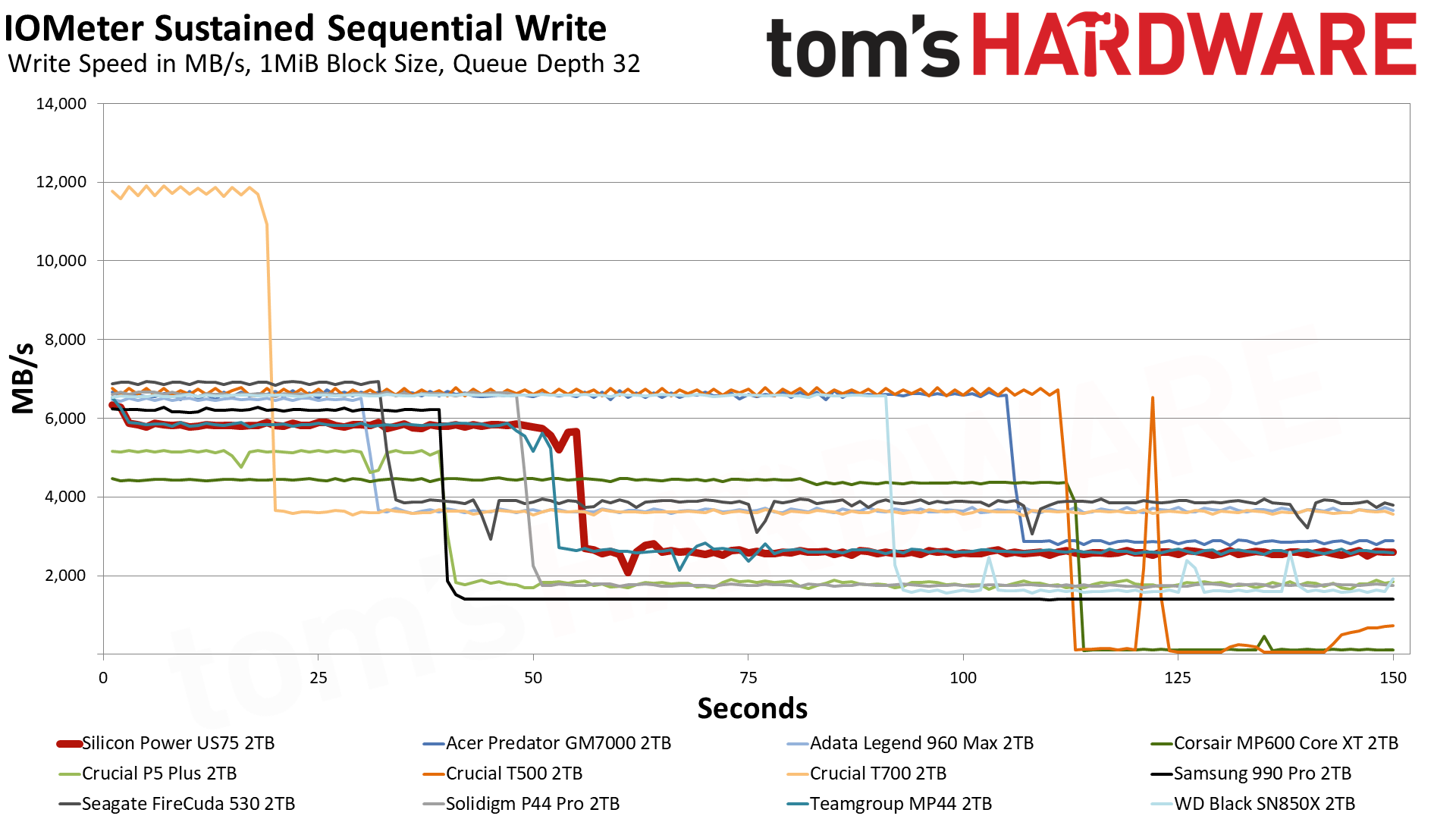
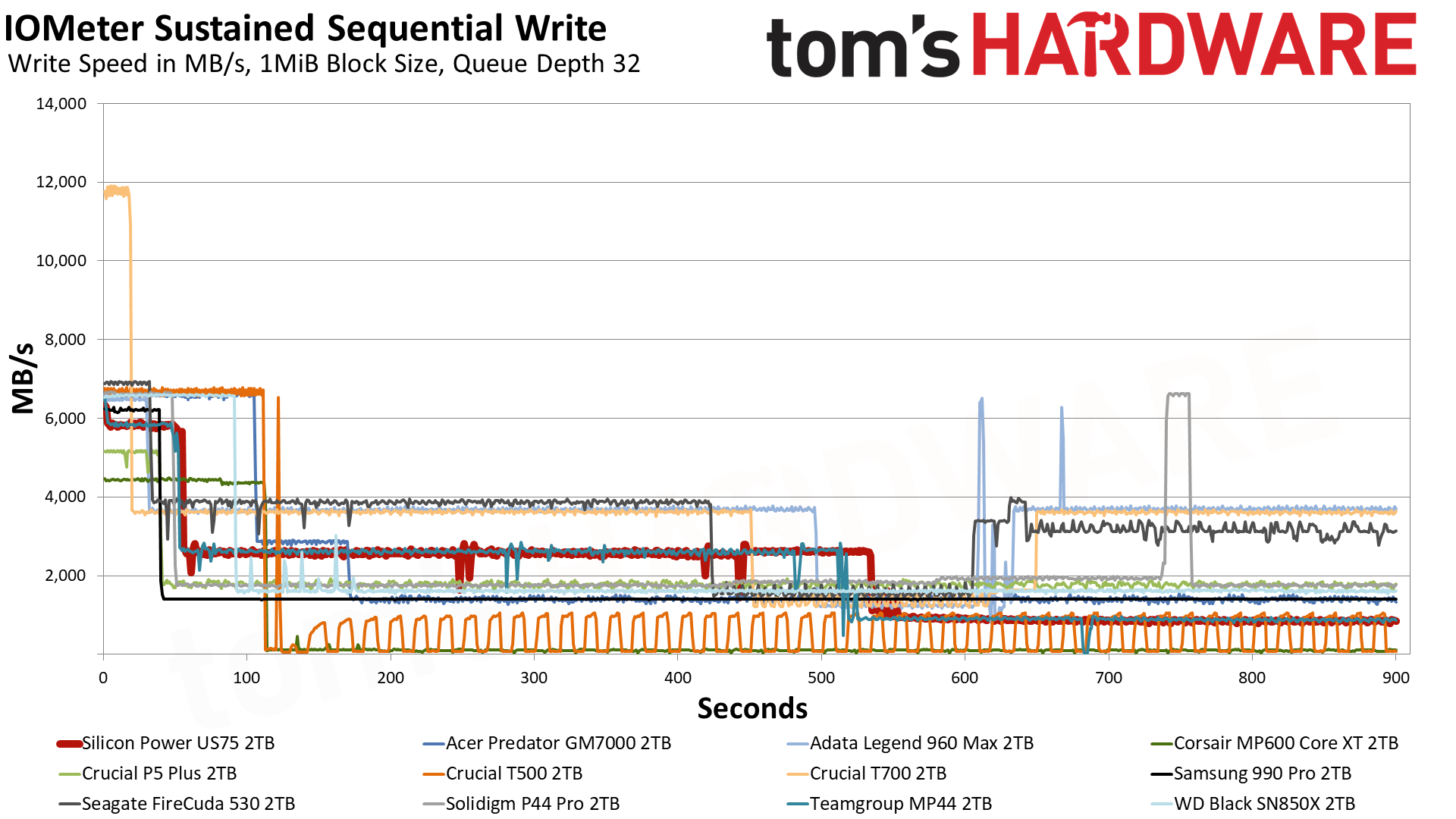
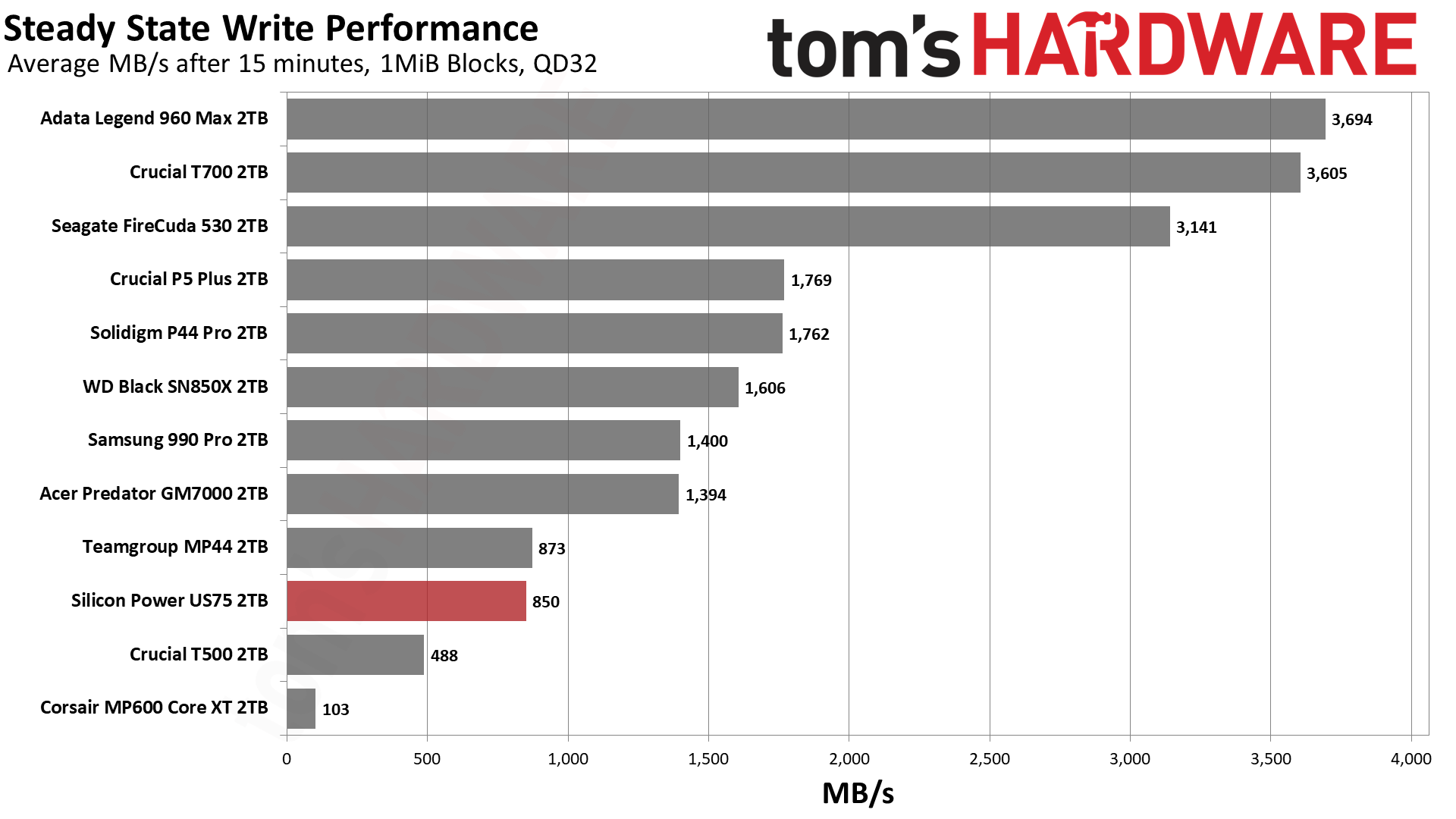
The US75 has a somewhat odd writing pattern. It writes at its fastest speed, around 6.3 GB/s, for two seconds, then drops to a more normal 5.8 GB/s. Drives using this controller tend to have fully dynamic pSLC caches, but this response is reminiscent of a hybrid cache with the subtle performance step. A hybrid cache has a static portion, which must be of a small size as the cache is dedicated and uses flash outside of the user-accessible space.
Hybrid schemes have been popularized by Samsung’s TurboWrite and within Intel’s 660p line, including the 670p and Solidigm P41 Plus. More recently, it has been used on a number of drives, including the P44 Pro. A static cache can allow for more consistent performance, particularly when the drive is fuller. The T500 reportedly uses a hybrid cache even though its post-cache response at launch proved inconsistent. However, this is likely tied to aggressive recovery of the dynamic portion and might be tweaked later in firmware.
The US75 enters a direct-to-TLC mode once the cache is exhausted, writing at up to 2.5 GB/s. This is very fast for a four-channel drive, faster than drives with Micron’s 176-Layer TLC like the Patriot P400. This is unsurprising as YMTC’s and Micron’s 232-Layer flash have six planes over the older four-plane designs, allowing for more interleaving. This means a higher maximum speed, but there will be variance by capacity considering the difference in flash density between generations.
The US75 then drops to a folding state in the 800-900 MB/s range. Eventually, it jumps back up to TLC levels of performance. Folding speed is slower as writes are forced to go through pSLC, which adds a pSLC write and then a pSLC read to the TLC write. However, the performance recorded is lower than expected as the controller simultaneously flushes the cache to native TLC in the background, enabling the drive to recover when given sufficient time.
This pattern yields a steady state write performance of 850 MB/s which is lower than anticipated but still better - and more consistent - than the T500’s post-cache response. It closely resembles the pattern of the 2TB MP44. With enough flash, we can see this hardware rise to that 2500+ MB/s level, as in our 4TB Lexar NM790 and Addlink S93 reviews. These drives are undoubtedly most impressive at 4TB with this controller and flash, but fast enough at lower capacities.
With eight-channel controllers, higher TLC speeds will be possible, but that imposes new challenges, such as maintaining power efficiency and managing heat. For now, we recommend existing high-performance Gen 4 drives like the P44 Pro, SN850X, or 990 Pro if you need wide-ranging performance, particularly at 2TB and below. The 4TB Samsung 990 Pro remains the champion at 4TB, with the SN850X being a solid second choice, but that level of performance will not be felt in the general desktop experience with half-full drives.
Power Consumption and Temperature
We use the Quarch HD Programmable Power Module to gain a deeper understanding of power characteristics. Idle power consumption is an important aspect to consider, especially if you're looking for a laptop upgrade as even the best ultrabooks can have mediocre storage.
Some SSDs can consume watts of power at idle while better-suited ones sip just milliwatts. Average workload power consumption and max consumption are two other aspects of power consumption, but performance-per-watt is more important. A drive might consume more power during any given workload, but accomplishing a task faster allows the drive to drop into an idle state more quickly, ultimately saving energy.
For temperature recording we currently poll the drive’s primary composite sensor during testing with a 24C ambient.
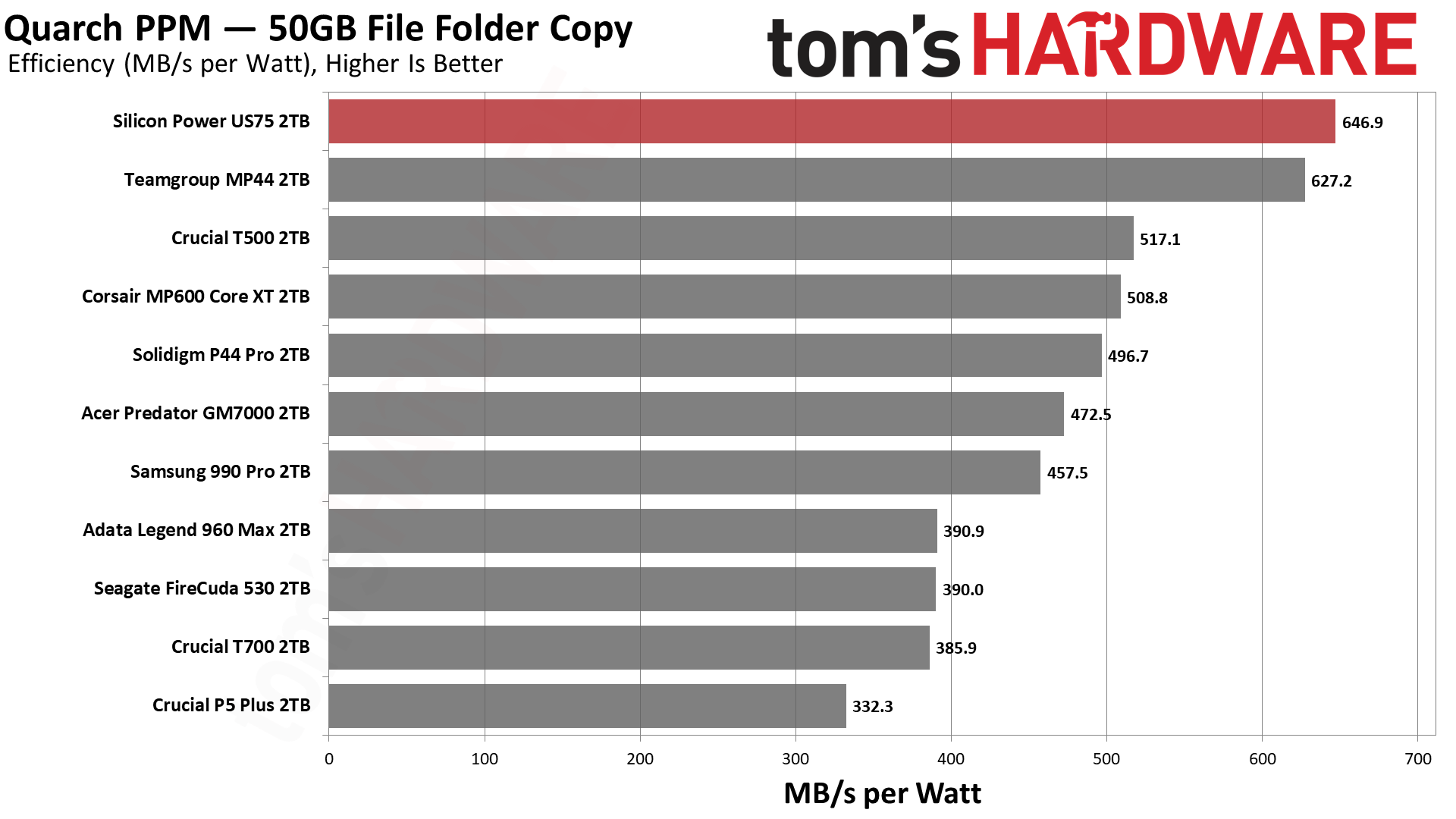
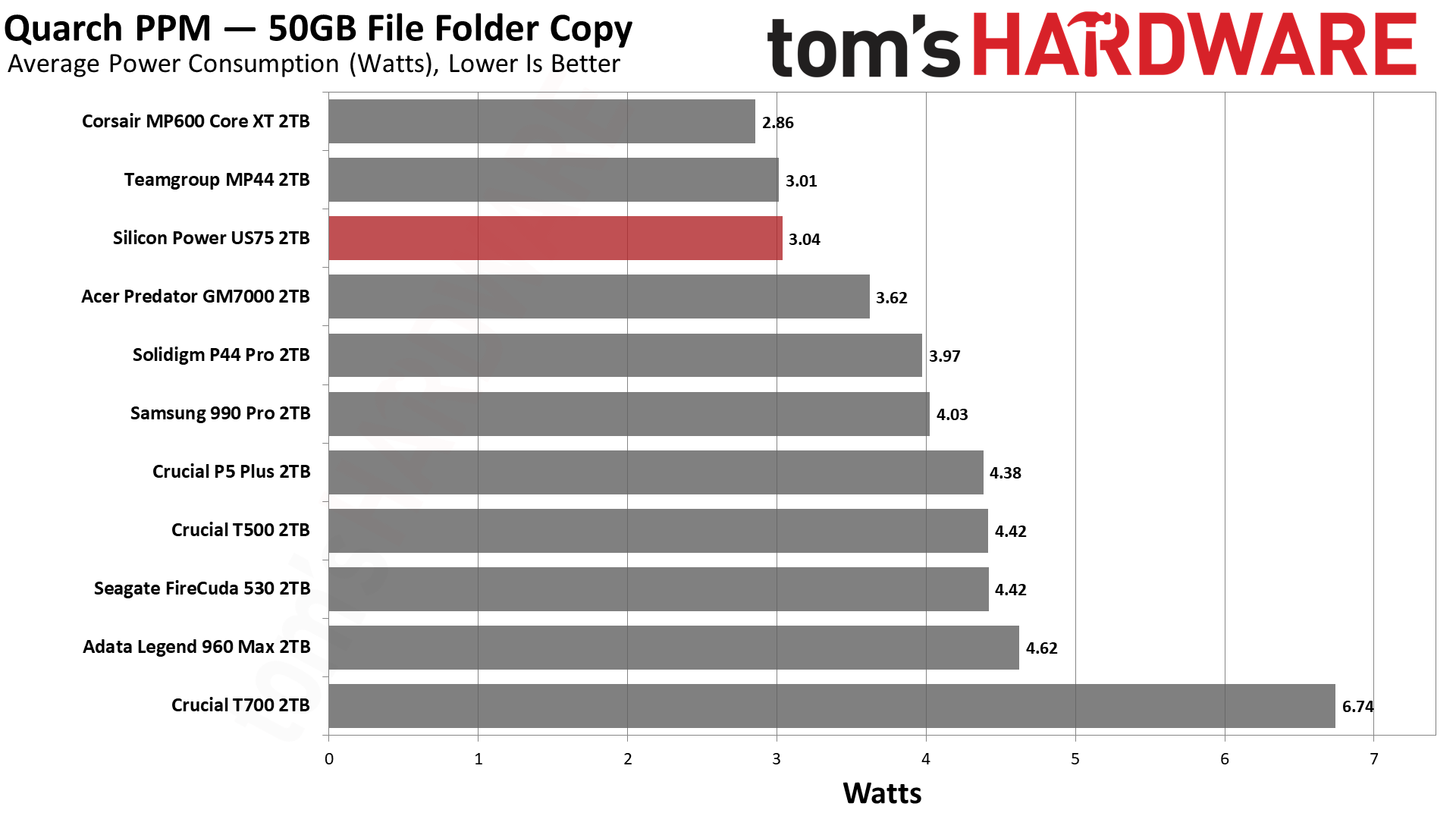
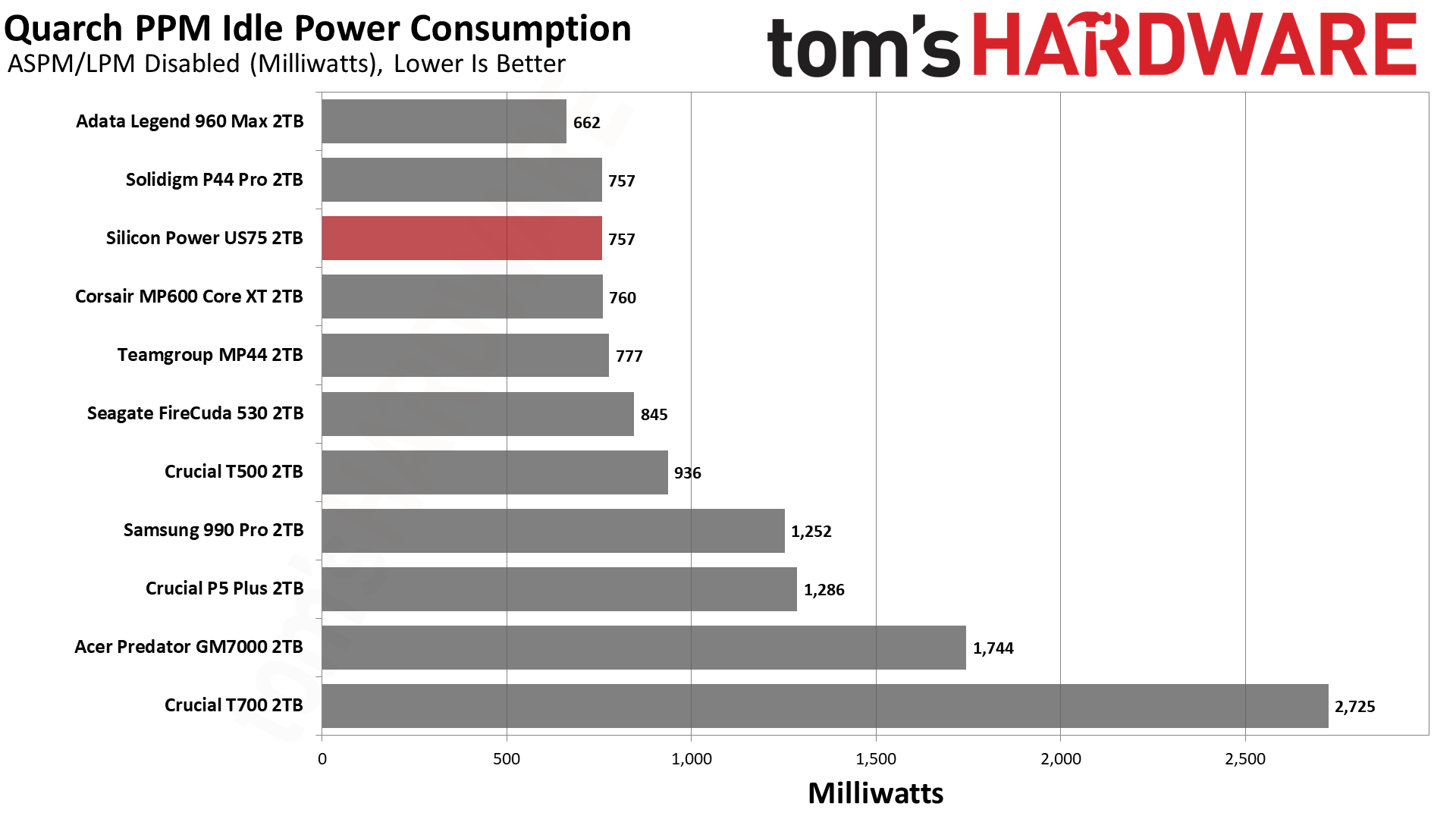
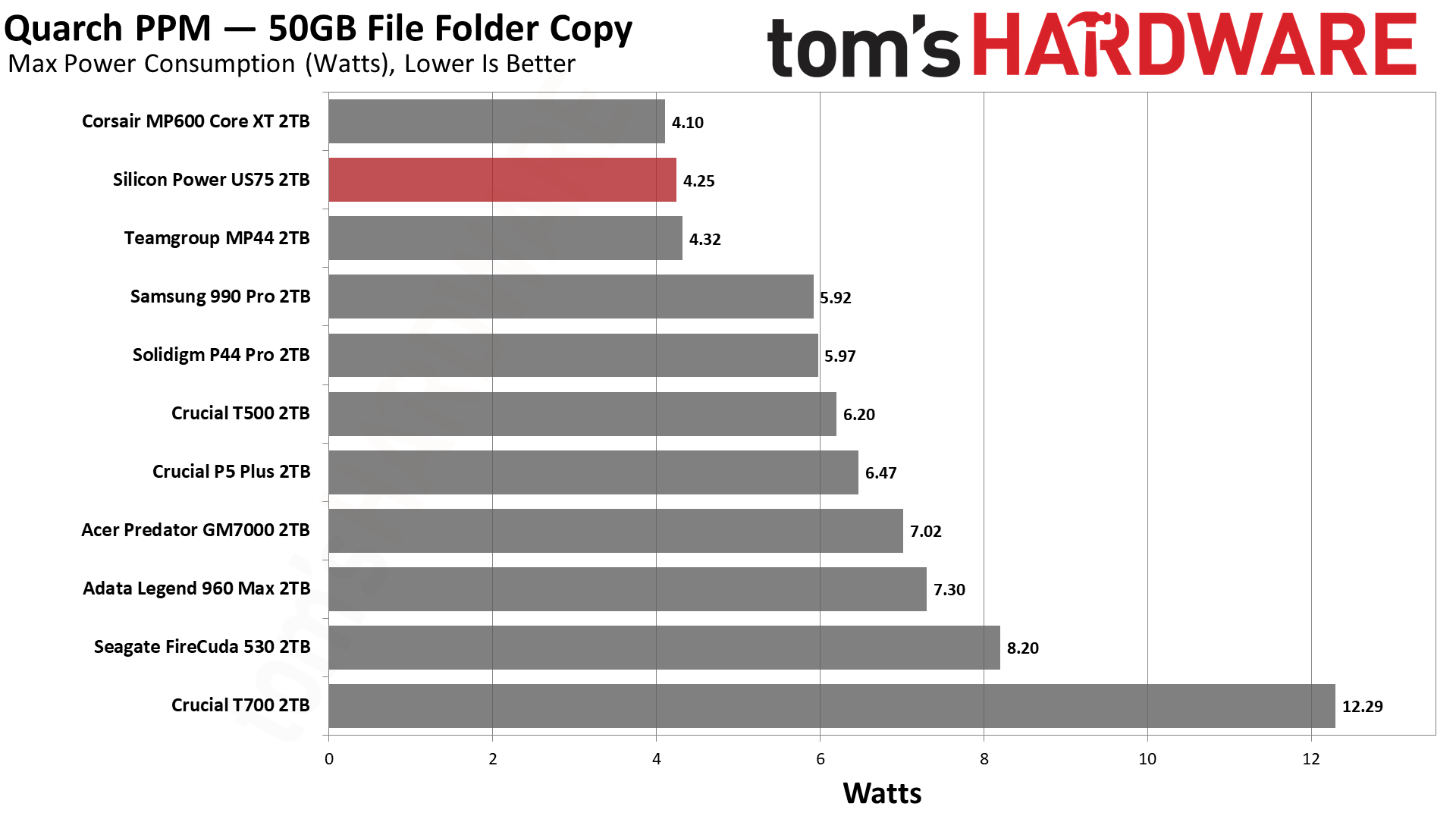
The US75 is very efficient, making it useful in almost any device. However, we warn that the controller runs very hot, so it benefits from additional cooling, such as a heatsink. Bare or heatspreader-clad drives might be problematic in some laptops with this hot spot. DIY cooling may be possible in some cases to help spread out the heat more.
The reported composite sensor generally stayed below 50C in our testing, which matches our expectations given the high efficiency. Without a lot of writing, this drive should stay even cooler, and cooler yet in a PCIe 3.0 slot. However, we still recommend cooling the drive or controller more effectively if possible, although the heatspreader is better than nothing. The T500, in comparison, has no such issue with its larger, metal-clad IHS.
Test Bench and Testing Notes
| CPU | Intel Core i9-12900K |
| Motherboard | Asus ROG Maximus Z790 Hero |
| Memory | 2x16GB G.Skill DDR5-5600 CL28 |
| Graphics | Intel Iris Xe UHD Graphics 770 |
| CPU Cooling | Enermax Aquafusion 240 |
| Case | Cooler Master TD500 Mesh V2 |
| Power Supply | Cooler Master V850 i Gold |
| OS Storage | Sabrent Rocket 4 Plus 2TB |
| Operating System | Windows 11 Pro |
We use an Alder Lake platform with most background applications such as indexing, Windows updates, and anti-virus disabled in the OS to reduce run-to-run variability. Each SSD is prefilled to 50% capacity and tested as a secondary device. Unless noted, we use active cooling for all SSDs.
Conclusion
The Silicon Power US75 doesn’t bring anything new to the table, but that’s not necessarily bad. It uses hardware we know to perform well, and it operates very efficiently. It’s single-sided, so it is compatible with most laptops and has no real deficiencies to keep it from being good for a wide range of applications. Its main sticking point is probably price, but it currently does a fair job of being competitive at 2TB. At the time of review its standard price was even a few dollars cheaper than early Black Friday prices on the P44 Pro - although we’d recommend the latter at these prices.
In fact, we’d recommend the P44 Pro, SN850X, or 990 Pro in general if you are looking for the best performance up to 2TB. The US75 is not yet available at 4TB, where the NM790 and A93 still dominate, and for maximum performance, the SN850X or 990 Pro are good choices. The 500GB model is also unavailable, although we don’t think this drive would be particularly good at that low capacity. At 1TB, many drives are comparable or better for a lower price. This leaves the US75 to shine at 2TB for a budget drive as it currently undercuts the similar MP44.
The US75 is a good choice for laptops, desktops, and the PS5s at 2TB, with only minor caveats. The MAP1602 controller does run hot even though the drive is efficient and overall heat production is not high. It also falls behind the T500 in many cases, but the US75’s pricing advantage keeps it reasonable. The T500 and some other drives in this class - the NM790 and A93 - have heatsink options, which does offer peace of mind, particularly as the heatsinks are PS5-compliant. The US75 is simply left as a competent alternative that has to win on price, which frankly sounds like Silicon Power’s M.O.
MORE: Best SSDs
MORE: How We Test HDDs And SSDs
MORE: All SSD Content

Shane Downing is a Freelance Reviewer for Tom’s Hardware US, covering consumer storage hardware.
-
shaolin95 This seems to beat the WD 850x at least based on the tests here or am I missing something?Reply -
Lloydsen I just bought the US75 4TB model and it seems they swapped the NAND Flash to part number YMC8G008Tb78CA1C0 which I believe is QLC. The speed drops to less than 100MB/s and it took me 32 minutes to transfer a single 170GB zip fileReply -
Skye771 Reply
Any proof of this? cant find anything about it onlineLloydsen said:I just bought the US75 4TB model and it seems they swapped the NAND Flash to part number YMC8G008Tb78CA1C0 which I believe is QLC. The speed drops to less than 100MB/s and it took me 32 minutes to transfer a single 170GB zip file -
Lloydsen Reply
https://i.imgur.com/Oc4mQQq.jpgI only have the image I took before I returned the SSD.Skye771 said:Any proof of this? cant find anything about it online
I am not sure if there were any changes since then. -
colohgc WARNING!!! US75 2TBReply
The production batch that is on the market is on QLC? chips!
I bought the drive in Poland, supposedly directly from Silicon Power Netherlands,
the drive arrived originally sealed and it already had 2TB of stored data and 4h of operation!
Writing speeds of 50 MB/s, connected to PCIe 3.0 x4
I returned it.
TRAGEDY
https://i.imgur.com/lURERfj.pnghttps://i.imgur.com/7cQUUtM.png
